July 12, 2007
Networked_Performance Upgrade
Dear Readers,
We are making final adjustments to our new blog which we hope to launch later today. Now a WordPress blog, it has been re-designed and has added functionality, most notably "Live Stage" (for events in real-time). And our comments will be turned on again!
Thanks to Mushon Zer Aviv - Shual.com (design) and Dan Phiffer (developer).
Thanks for your continued interest and support.
Jo and Helen
Posted by jo at 09:58 AM | Comments (0)
July 11, 2007
Placeholder: Voiceholders and Voicemarks

Brenda Laurel writes: "[...] Rachel has described our interest in how people leave marks on places. We wanted to give people the ability to "mark" the virtual environments, and we arrived at voice as a convenient modality for doing so. Voice offered several advantages over writing or drawing. Through prosody, voice permits greater expressiveness and personalization than writing; it is also more immediate. Most people are less self-conscious about speaking than about drawing. While drawing would require that we build special virtual drawing tools, capturing voice was relatively easy to implement.
Where and how could voices be stored and re-played? We designed the Voiceholders as virtual record/playback devices. A Voiceholder would capture and store an utterance, called a Voicemark. A "full" Voiceholder (that is, one containing a Voicemark) would play its contents when touched. In order to encourage people to play with relationships among Voicemarks and between Voicemarks and landscape features, we made the Voiceholders moveable, exempt from gravity, and able to be placed anywhere one could reach. Voiceholders could be moved by grabbing them (closing the grippees while the points of light were "inside" the rock), dragging them to the desired location (they would stick to your hand), and releasing the grip.
We wanted people to think of the Voiceholders more as tools or agents than as devices; machines (including tape recorders) were inconsistent with the fantasy context. We designed them as rocks with faces, using the facial expressions to indicate the state of the Voiceholder. This was as close as we came to an iconic or symbolic interface element..."
Image: When a voiceholder was empty, its eyes and mouth were closed and it was dark. When a person touched an empty voiceholder, its eyes would open and it would light up from the inside (rather like a jack-o'-lantern) and a voice (emanating from the voiceholder) would say "I'm listening." If a person spoke when a voiceholder was in that state, their speech would be recorded. When the voiceholder became "full" (i.e., ran out of space in the sound file it was creating) the inner light flickered and then went out (rather like a guttering candle), the yes would close and the mouth would open to indicate that it was ready to speak. If a person touched a voiceholder in this state, it would open its eyes, light up and play back its contents, then it would "go to sleep" again.
From Placeholder: Landscape and Narrative In Virtual Environments :: ACM Computer Graphics Quarterly Volume 28 Number 2 May 1994 :: Brenda Laurel, Rachel Strickland, Rob Tow, Interval Research Corp :: Copyright © 1994 by the ACM. Videos available here.
Posted by jo at 07:34 PM | Comments (0)
Avatar News: The Virtual Teacher +
![]()
Future avatars will be adept at manipulating human response
"Researchers from Illinois and Florida are developing a networking system which will create virtual representations of real people to improve our knowledge. They will use artificial intelligence and natural language processing software to enable us to interact with these avatars. The goal of the project, sponsored by the National Science Foundation (NSF), is to give us the possibility to interact with these virtual representations as if they were the actual person, complete with the ability to understand and answer questions. We should see the results at the beginning of 2008 — if the researchers succeed." [via]
"The current technology for creating computerized avatars for human interactions is relatively primitive; we tend to be surprised if a computerized representation can perform even vaguely human behaviors. But in the latest issue of Science, Judith Donath of MIT's Media Lab argues that this situation is likely to be temporary. She suggests that as programmers respond to the demand for more realistic human behavior in avatars, they will necessarily create the technology to manipulate human trust via the results.
Donath notes that even seemingly simple human behaviors are accompanied by collections of body language and expressions that can reinforce or undercut the messages we intend to send. For instance, she suggests that we signal our intention to engage someone in conversation by a complex suite of gestures, mostly nonverbal: "You carry out this goal not only by walking across the room but also by making eye contact, smiling, raising your brows, adjusting your clothes—a complex set of communicative behaviors that indicate your intention to start a conversation, allow you to gauge his willingness to do so, and show your level of determination."
Right now, even the most sophisticated avatars accomplish only a small subset of these behavioral collections. But that's beginning to change, at least within the research community. Although putting all of the components of these behaviors under user control is viewed as too complex, Donath cites work in which entire suites of behavior could be controlled by a single command. For example, an avatar commanded to end a conversation can nod its head, wave, and break eye contact. Users of such systems found them natural and more engaging, and they found their conversation partners to be more expressive.
Although these sorts of advances may make for a more appealing virtual experience, Donath suggests that they have some disturbing implications for issues of trust and credibility when future avatars are used for communication. She notes that we interpret many behavioral collections in light of what they tell us about the person who is doing the talking. For example, we tend to view someone who doesn't make eye contact as more likely to be lying, providing uncertain information, or simply uninterested in talking with us. A well-programmed avatar can be commanded to engage in behaviors that simulate honesty, regardless of whether the speaker is trustworthy.
Research is also revealing that other factors play into an avatar's trustworthiness and credibility. For example, simply making an avatar appear more human (including providing it with a clear gender) caused them to be rated more trustworthy. Other research has shown that trust can also be manipulated via more subtle techniques. Teams of people paid greater attention to an avatar that was created with a "team face," one that combined features from the members of the team. Individuals found political messages more persuasive when they were delivered by an avatar with a subtle resemblance to the listener's own face.
Donath specifically raises the disturbing possibility of, "a world in which you are bombarded with oddly compelling ad campaigns presented by people just like you." But she also suggests that current trends, if they continue, may leave us with avatars tailored to the contexts where they're used. After all, we demand detailed and elaborate avatars for our online fantasy games but will happily accept far less for what's billed as our "Second Life." It's possible that we'll actually wind up demanding less sophisticated avatars to deliver the most critical information in order to avoid the potential for manipulation. But only, of course, if we're aware of the danger." Future avatars will be adept at manipulating human response by John Timmer, Ars Technica. Related: Our avatars, ourselves.
Posted by jo at 05:56 PM | Comments (0)
July 10, 2007
Andrew Keen:

Rescuing 'Luddite' from the Luddites
"[...] A Luddite argument is one in which some broadly useful technology is opposed on the grounds that it will discomfit the people who benefit from the inefficiency the technology destroys. An argument is especially Luddite if the discomfort of the newly challenged professionals is presented as a general social crisis, rather than as trouble for a special interest. (“How will we know what to listen to without record store clerks!”) When the music industry suggests that the prices of music should continue to be inflated, to preserve the industry as we have known it, that is a Luddite argument, as is the suggestion that Google pay reparations to newspapers or the phone company’s opposition to VoIP undermining their ability to profit from older ways of making phone calls.
This is what makes Keen’s argument a Luddite one — he doesn’t oppose all uses of technology, just ones that destroy older ways of doing things. In his view, the internet does not need to undermine the primacy of the copy as the anchor for both filtering and profitability.
But Keen is wrong. What the internet does is move data from point A to B, but what it is for is empowerment. Using the internet without putting new capabilities into the hands of its users (who are, by definition, amateurs in most things they can now do) would be like using a mechanical loom and not lowering the cost of buying a coat — possible, but utterly beside the point.
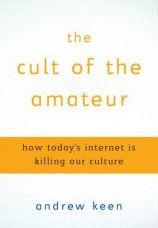
The internet’s output is data, but its product is freedom, lots and lots of freedom. Freedom of speech, freedom of the press, freedom of association, the freedom of an unprecedented number of people to say absolutely anything they like at any time, with the reasonable expectation that those utterances will be globally available, broadly discoverable at no cost, and preserved for far longer than most utterances are, and possibly forever.
Keen is right in understanding that this massive supply-side shock to freedom will destabilize and in some cases destroy a number of older social institutions. He is wrong in believing that there is some third way — lets deploy the internet, but not use it to increase the freedom of amateurs to do as they like.
It is possible to want a society in which new technology doesn’t demolish traditional ways of doing things. It is not possible to hold this view without being a Luddite, however. That view — incumbents should wield veto-power over adoption of tools they dislike, no matter the positive effects for the citizenry — is the core of Luddism, then and now." From Andrew Keen: Rescuing 'Luddite' from the Luddites [posted by Clay Shirky on Many-to-Many]. Also see "The internet's output is data, but its product is freedom".
Posted by jo at 07:20 PM | Comments (0)
The Hole in the Wall:
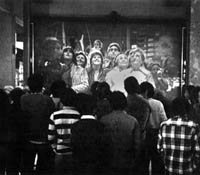
How Humans Connect No Matter What
In 1980, on a November evening in Los Angeles, pedestrians who walked past the glass windows of the Broadway Department Store noticed something strange…they did not see their reflection. There were other people walking by, just not them. They ended up talking with the alien reflections and realized that they were in two different locations, indeed, on other sides of a country: the Lincoln Center for the Performing Arts in New York City and the Broadway Department Store in Century City in LA. This work, called Hole-in-Space, was created by Kit Galloway and Sherrie Rabinowitz.
Last year I was recruited to a group to consult on a project for the Australian communications company Telstra. I recommended that Telstra, given their core brand is (I believe) enabling people to communicate with each other (not tourism!), that they install a contemporary version of Galloway and Rabinowitz’s work. Using their substantial communications infrastructure they could link together two key and important communities: rural Australia with urban Australia; and Australians in the street with people in the streets of the online virtual world Second Life. The project has been put on hold indefinitely and since the future of the project is unknown and I wasn’t compensated for my advice, I’m sharing it here. But recently I came across a different iteration on the theme, and one that bypasses the corporate and art world.
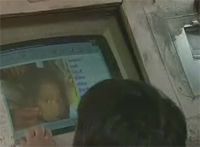
A few years ago Dr. Sugata Mitra, head of research and development at an IT firm in India, installed a computer in the wall of a slum area in India. He put it in to enable the children to use the computer and the Internet for free. He wanted to see what the children would do if they had unlimited and free access to these technologies. He called it the Hole in the Wall experiment. Within minutes, a Frontline segment explained, the children taught themselves computer literacy. Dr. Mitra has installed computers in many areas now and revels in the response. He is quite conscious of the immense impact of his cybernetic seed:
“If cyberspace is considered a place,” Mitra tells FRONTLINE/World, “then there are people who are already in it, and people who are not in it … I think the hole in the wall gives us a method to create a door, if you like, through which large numbers of children can rush into this new arena. When that happens, it will have changed our society forever.”
The segment told the story of the first boy to teach himself the computer and Net: Rajinder. He creates things using paint programs, plays games and browses the Disney website. His teacher notes that ‘he has become quite bold and expressive’.
When Dr. Mitra asks Rajinder to define the Internet, the doe-eyed boy replies immediately, “That with which you can do anything.”
And so, we move from people connecting with each other, to people tapping into possibility. The continuing theme, whether it is enunciated by artists, the corporate world or a single person who wants to heal the rift of the digital divide, is that of creating portals where once there where walls. It doesn’t matter if the wall, the ostacle is financial, cultural, geographic or technological, we’ll find a way to dissipate it. I’m so happy to have front-row seats to one of the most amazing times in Earth’s history.
Check out full Hole in the Wall article and video by journalist Rory O’Connor, and the amazing collection of Social Entrepenuers videos at Frontline/World. Thanks to Guy Kawasaki for posting about it. [blogged by Christy Dena on Cross-Media]
Posted by jo at 06:59 PM | Comments (0)
Physicality
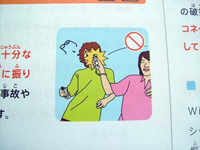
A return to physical devices
The 2nd part of Don Norman’s two part essay on “The Next UI Breakthrough” [RESTRICTED ACCESS] appears in the July/August 2007 edition of ACM Interactions. In it, he describes how physicality is now being re-introduced into the user interface for computers. He describes physicality as more extensive than tangible computing and “embodiment” (Paul Dourish’s explication of computing that is both social and tangible because the manipulation and handling of objects is always part of social activities.) For Norman, “physicality” is something new in that it is a return after a period of user interfaces in which mechanical manipulation of things like knobs and dials and switches was avoided in favor of things like the so-called soft switches. Now switches and dials have returned, as have more advance interface forms that can respond to gesture.
Physicality: the return to physical devices, where we control things by physical body movement, by turning, moving, and manipulating appropriate mechanical devices.
We have evolved as physical creatures. We live in a complex, three-dimensional world filled with physical objects. We are analog beings in an artificial world of digital devices, devices that abstract what is powerful and good from the physical world and turn it into information spaces, usually in arbitrary ways. These new approaches put the body back into the picture. They require us to control through physical action rather than virtual, which means through mechanical devices, not electronic or graphic.
I’d speculate that part of the return has to do with the fact that the old metaphors of turning a knob, for example, are effective and meaningful. But beyond just switches and control inputs, Norman seems to be speculating that the return to physicality will present opportunities for new kinds of interaction, beyond just switching things on or off, and, hopefully, for interaction beyond typing. Despite Norman’s observation that we’re returning to physical controls, one form of physical control — the keyboard — has never left. I’d be interested in forms of user interface that didn’t even touch the kinds of computing models that keyboards enforce. Can there be a form of computing that relies entirely on physical movement rather than tapping on little plastic squares? [blogged by Julian Bleecker on techkwondo]
Posted by jo at 06:34 PM | Comments (0)
San Francisco Sex Worker Film and Arts Festival
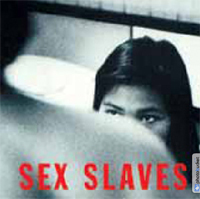
Screenings, Conversation and Party
The 5th Biennial San Francisco Sex Worker Film and Arts Festival :: July 14 - 22 :: The San Francisco Sex Worker Festival was established in 1999 to provide a forum for the accomplishments of sex worker artists and filmmakers and to show work about sex workers and sex industries from around the world. The Sex Worker Festival provides an opportunity to recognize and honor prostitutes, dancers, porn performers and other sex workers who have historically been a dynamic part of arts communities. The Festival includes performance events, parties, art exhibitions, film screenings and educational discussions and seminars. Visit our website for full schedule and event details, and come join in on the fun!!
1. Asian Sex Worker Film Screening at Ar+Space :: July 20, 7-9 PM :: Location ar+space gallery (1286 Folsom Street (nr 9th) :: Sliding Scale $5-$20 (no one turned away for lack of funds).
We, Asian Sex Workers is screening videos by sex workers from San Francisco and from around the globe. We are proud to have the opportunity to present the premiere screening of "Memory of Mrs. Guan," the story of the leader of the sex worker movement, Guan Xiou Qin (of COSWAS in Taiwan) who committed suicide recently as a culmination to her political struggles. These videos range widely from this very political memoir to the experimental work "Whore's Diary : Pornography made by me & my client by BuBu de la Madeleine. Miss Erochica's Burlesque Diary explores a background of images through which burlesque artist, Erochica Bamboo, constructs her persona. This collection provides a unique view of Asian women in the sex industry, usually portrayed as victims and slaves, here portrayed as strong, often political, proud and sexy individuals with a range of goals and struggles.
2. We, Asian Sex Worker Exhibit: Migrant Sex Work Forum and Discussion in conjunction with 5th Sex Worker Film and Arts Festival :: July 18, 7PM :: ar+space gallery (1286 Folsom Street (nr 9th) :: Prices: Sliding Scale $5-? (no one turned away for lack of funds).
7pm: Migrant Sex Work Panel and discussion - Panelists include local experts in issues of sex worker and migration. Topics include the underside of 'rescues,' adverse impact of US trafficking policies, migrant rights and more.
8pm: Urban Justice Center presents "Taking the Pledge" USAID money, anti-prostitution pledges and migrant sex work presentation/discussion. Taking the Pledge by Melissa Ditmore & Erin Siegel (Network of Sex Worker Projects) - 13 min - Powerful activist detailing with interviews spanning the globe, addressing the impacts of new US funding restrictions under the Bush administration.
9pm Melissa Gira: Report Back from Cambodia - Representing Desiree Alliance, the Ms. Gira recently attended a consultation in Cambodia held in conjunction with The Sexual Health and Rights Project of Soros' Open Society Institute to organize cross cultural efforts to support sex worker rights.
3. Roaming Hookerfest: Outdoor Video Projection Roaming the Streets of San Francisco in conjunction with the San Francisco Sex Worker Film and Arts Festival :: July 20, 9-11PM :: 1st screening at corner of 16th and Folsom (route to be posted at website) :: Free.
The Roaming Hookerfest is a traveling outdoor caravan of sex workers bringing the films to the street. This first-ever Roaming Hookerfest was developed by Festival co-director, Erica Berman (AKA Fabulous). Fabulous wanted the festival to reach out past the usual crowds so she created this guerilla art event. On Friday night of the festival we will be driving a movie van with films and safer sex materials to alleyways throughout San Francisco. We will be showing a half hour of excerpts and short films highlighting the festival. We will post the locations and the list of movies at our site.
Meet us at 16th and Folsom at 9 PM for an elegant soiree on the streets. Dress up or dress down! Join our caravan afterwards for a party at Lipo Lounge, Red Lit Dance Nite with DJ Bent in Chinatown. Drink, eat Chinese food and discuss 'sex worker sinema' with sex workers from around the country.
The movies we will screen focus on entertainment for sex workers on the street including The Aphrodite Project by Norene Leddy which presents magical hooker platforms, designed for the street hookers of the future, and Jyanta Meetei's Street Survivor a precious portrait of a Taiwanese street hooker, her time and the cop who arrested her.
4. Red Lite Dance Nite-Afterparty for the Roaming Hookerfest :: July 20, 2007; 11pm :: Venue: Lipo Lounge, 916 Grant (nr Washington) :: $5-20 sliding scale; free for ho's with no dough
An incredible nite of booty beats, reggaeton rythms, and more music than you can imagine at the Red Lite Dance Nite!!! An extremely rare West Coast appearance by the infamous DJ bent - spinning reggaeton, funk carioca, hip-hop, baltimore club, miami booty bass, reggae/dancehall, and a whole lot more.
This is the after party for the Roaming Hookerfest, so drink, dance, eat Chinese food nearby and discuss 'sex worker sinema' with sex workers from around the country. This party supports Sex Worker Arts & Film Festival and this fall's National Sex Worker Activist Trainings.
Media Contacts: 310-562-8201; 415-751-1659
Telephone number (public): 415-99-ASIA-9 (415-992-7429)
Posted by jo at 04:31 PM | Comments (0)
Volunteers Needed for Conflux Festival 2007
![]()
Glowlab seeks volunteers to work with the fourth annual Conflux Festival, taking place in Williamsburg, Brooklyn from September 13th-16th. We're looking for volunteers in a variety of areas: tech support, audio / video / photo documentation, general installation, sales, event staff. You'll have the opportunity to assist national and international artists, work with local venues and get hands-on production experience. Previous event production experience is preferred, but not required.
About Conflux: Conflux is the annual New York City festival where visual and sound artists, writers, urban adventurers and the public gather for four days to explore the physical and psychological landscape of the city.
Volunteer Requirements: You must: have a working mobile phone; be available for at least one full day of the festival; be able to attend a short volunteer meeting Monday August 20th and / or Monday September 10th from 7pm-8pm. For more information, contact Sarah Pace: pace[at]confluxfestival.org
Posted by jo at 03:21 PM | Comments (0)
[1001] 1001 nights cast news
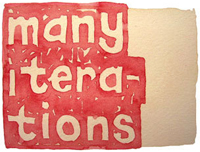
Have your Say, Workshop and more
1001 NIGHTS CAST News: THE THREE-QUARTER MARK; YOUR SAY; MOVING TIMEZONES; LONDON WORKSHOP.
THE THREE-QUARTER MARK: Sometime between tonight's performance (#750) and tomorrow's I will pass the three-quarter mark of the project. Since the two-third mark back in April, I'm very honoured to have performed stories by these new contributors to the project: Jordan Peimer (LA), Peter S. Petralia (London), Catherine Lord (LA), Adrian Heathfield (London), Sara Jane Bailes (Bristol), Karen Christopher (Chicago), Rinne Groff (NYC), Rebecca Schneider (NYC), Tony White (London), Geoffrey Batchen (NYC), Trevor Smith (NYC), Kate McIntosh (Brussels), Michael Grosberg (NYC), Hannah Chiswell (UK), Angela Piccini (Bristol), Lina Saneh (Beirut), Thalia Field (Paris), Alisa Lebow (London), Jane Gleeson-White (Sydney), Robin Bale (London), Branislava Kuburovic (Prague), Lara Pawson (London), Matias Viegener (LA), Kathryn Ryan (Sydney), James Tierney (Portland), Linda Dement (Sydney), Agnes Kocsis (London) and Nicholas Royle (London).
YOUR SAY: There is a new feedback section on the site. It's called Your Say. If you want to make a comment about a story, a performance or the project in general, please Have Your Say. You can choose to have it published on the site or to keep it private. If you want to see the published comments, hit the What You Said button.
MOVING TIMEZONES: The project moves to London on Tuesday July 17. That night, performance # 757 will be webcast at 9.10pm. That is: 10.10pm in Paris, Madrid and Prague 11.10pm in Jerusalem, Beirut and Istanbul 4.10am, July 18 in Perth, Hong Kong and Manila 6.10am, July 18 in Sydney 7.10am, July 18 in Auckland 4.10pm in New York, Toronto and Bogota 1.10pm in Los Angeles
LONDON WORKSHOP: Ten writers from the UK will join Barbara Campbell in London on July 20, 21 and 22 to write a three part story for the project. The writing workshop is part of DIY 4. DIY 4 is a collaboration between the Live Art Development Agency, Artsadmin, and New Work Network, and is being developed with Nuffield Theatre/LANWest, New Work Yorkshire, Fierce Festival, Colchester Arts Centre, The Basement Arts Production South East, and Dance4. DIY 4 is part of Joining the Dots, a Live Art Development Agency initiative supported by the Esmée Fairbairn Foundation and the Calouste Gulbenkian Foundation.
Posted by jo at 02:41 PM | Comments (0)
July 09, 2007
Camping in the Gigital Wilderness:
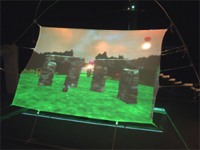
Tents and Flashlights as Interfaces to Virtual Worlds
"ABSTRACT: A projection screen in the shape of a tent provides children with a shared immersive experience of a virtual world based on the metaphor of camping. RFID aerials at its entrances sense tagged children and objects as they enter and leave. Video tracking allows multiple flashlights to be used as pointing devices. The tent is an example of a traversable interface, designed for deployment in public spaces such as museums, galleries and classrooms.
Keywords: Virtual environments, immersive and traversable interfaces, RFID, video tracking, single display groupware.
INTRODUCTION: Pitching a tent and spending the night under canvass, with friends, a rucksack, a flashlight, surrounded by strange shadows and sounds, is an exciting experience for most children. It is also often the closest that many come to the wilderness, a primitive unfamiliar place that is far removed from their everyday world...
THE TENT AS HCI: As an interface, the tent reflects several current concerns within HCI. First, it represents an example of a traversable interface that provides the illusion of crossing into and out of a virtual world. Previous examples have included fabric curtains, sliding doors, hinged screens and even water sprays [3]. The tent demonstrates an alternative in which participants enter a space that is defined by the screen, but where unlike CAVE-style immersive interfaces, the space outside the screen is also part of the experience." From Camping in the Gigital Wilderness: Tents and Flashlights as Interfaces to Virtual Worlds by Jonathan Green, Holger Schnädelbach, Boriana Koleva, Steve Benford, Tony Pridmore, Karen Medina (CHI 2002). [via pasta and vinegar]
Posted by jo at 08:22 PM | Comments (0)
MIT Media Lab: Responsive Environment Group
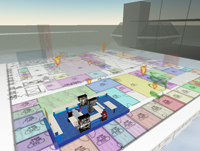
Dual Reality Lab
"Dual reality" is the concept of maintaining two worlds, one virtual and one real, that reflect, influence, and merge into each other by means of deeply embedded sensor/actuator networks. Both the real and virtual components of a dual reality are complete unto themselves, but are enriched by their mutual interaction. The Dual Reality Media Lab is an example of such a dual reality, as enabled the Plug sensor / actuator network that links our actual lab space to a virtual lab space in the Second Life online virtual world. [MOV]
SLIDE 7: Virtual Worlds >> Many attempts, many failures >> Potential to be as revolutionary as the WWW >> Example: Second Life by Linden Lab >> Key attributes: – shared immersive experience – persistent state – market economy – creative medium.
SLIDE 8: Taxonomy of Reality >> Virtual Reality (all simulated) >> Mixed Reality (some real, some simulated) >> Reality (all real) >> Augmented Reality (all real, some simulated) = mono realities. ALL OF THE SLIDES [PDF]
Posted by jo at 08:13 PM | Comments (0)
Gadgets may help merge virtual reality with real life
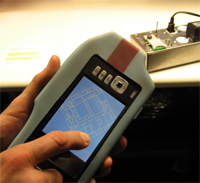
Living Through our Avatars
Gadgets may help merge virtual reality with real life by Mark Baard, Globe Correspondent, July 9, 2007: That hipster you always see talking into his Bluetooth headset might soon be able to use a similar device to leap into Second Life without even stepping out of line at Trader Joe's.
The company behind Second Life, Linden Lab, hopes to introduce hand-held and wearable systems that act as gateways between the real and virtual worlds. Linden Lab and other virtual worlds also are developing versions that run on existing mobile phones.
Researchers at a recent virtual worlds conference at MIT said that special eyewear, display "badges," and speakers worn about the neck will allow us to live more fully through our avatars -- those idealized versions of ourselves that typically boast better proportions than the saggy originals.
Second Lifers wearing the gadgets will be able to attend "in-world" parties and gallery openings, whether they are sucking down beers at Cornwall's or stuck in Fenway traffic. Motion detectors and other sensors in the devices will also show your virtual mates what you are up to in the real world.
It might sound like public safety officers will need to shift focus away from the risks associated with driving while chatting on cellphones to the inherent dangers of operating in two realities at the same time. But conference participants said such concerns are premature.
"It's like you're not going to be allowed to be in a virtual world while driving in the real world," said Robert Sutor, vice president of open source and standards at IBM.
Linden Lab vice president Joe Miller described one of the early products that will bridge the two worlds as a wearable box that creates a "3D sound field" that allows the wearer to hear voices from his virtual world without completely shutting out the real people around him.
The prototype speaker device presented to Linden recently by a developer "is not ready for prime time yet but it's working pretty well," said Miller, speaking at "Virtual Worlds: Where Business, Society, Technology & Policy Converge," sponsored by MIT and IBM.
Linden is encouraging open source developers to create client software for mobile devices. And Blizzard Entertainment, creator of the online multiplayer game World of Warcraft, is hiring developers with experience in Symbian and Adobe Flash Lite for its mobile interface initiative.
Conference participants said cellphones are likely to be the first mobile devices to create two-way connections between real and virtual reality.
"The idea of cell phone as sensor has started to catch on in the sensor network community," Joseph Paradiso, leader of the Responsive Environments Group at the MIT Media Lab, wrote in an e-mail last week. "They're much heavier platforms than usually seen in sensor networks, but they are certainly ubiquitous!"
ResEnv has produced a prototype "tricorder" -- inspired by the information- synthesizing gadget from "Star Trek" -- that gathers data from real-world surroundings and translates that information into virtual desks and chairs.
In a video at the ResEnv website, media.mit.edu/resenv, grad students demonstrate how the tricorder's sensors can detect someone swiveling in a desk chair and typing on a computer keyboard. The device can also show the user what is happening in the virtual space he or she is helping to create.
It will take some retooling before virtual worlds can accommodate all of the data streaming from ubiquitous sensors.
"We're talking with Linden Lab [about creating] more efficient pipes of sensor data into their environment," said Paradiso. "I can certainly stream video, but I can't efficiently input diverse sensor data."
Posted by jo at 08:03 PM | Comments (0)
CrowdSourcing Art
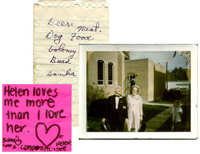
Relational Art
"Leah DeVun: You were an early advocate of crowdsourcing in the area of fine art. How did you first get involved in crowdsourcing?
Andrea Grover: Part of my interest in this is related to creating non-commodity-based artwork. I have a lot of personal affection for work from the mid-1960s and early 1970s, happenings and actions such as Gordon Matta-Clark’s Food in New York, which was in a sense a crowdsourced work -- an artist-run establishment where everything, from the cooking to the eating, was a part of the artwork. I also have a lot of fondness for early video collectives like Top Value Television, Videofreex, and Raindance. Video cameras and editing equipment were so cost-prohibitive that the only way to make a work was to do it collectively. So my interests in what’s happening now are to some extent born out of the socially-driven, collaborative works from that period. I first found the term “crowdsourcing” in Jeff Howe’s article in Wired in 2006. I think it gave people language to talk about something that they were seeing but didn’t really have a word for. I think one of the original terms people were using was “relational art” – in other words, crowdsourcing is a new term to describe something that already existed before the term was in common use, but the word gave people something to organize around, and it gave some shape to newer trends." Read the full interview here.
Posted by jo at 07:49 PM | Comments (0)
EXPERIMENTAL ART FOUNDATION presents
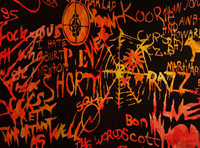
James Dodd and Ubermorgan.com
JAMES DODD | SPEAKEASY + UBERMORGEN.COM | WORK 1999-2007 :: 13 JULY - 18 AUGUST :: OPENING THURSDAY 6PM 12 JULY :: EXPERIMENTAL ART FOUNDATION, ADELAIDE SOUTH AUSTRALIA :: James Dodd Artist's talk: FRIDAY 17 AUGUST, 4PM ::
JAMES DODD uses images and logos from popular, sub, and outlaw culture to construct his artwork. Rock'n'roll, commercially and individually applied street cultures, and their modes, are all constants in Dodd's practice. Political comments and seemingly inane social observations come together in densely presented groups of work that offer critical analyses of Australian culture. The work explores critical examinations and applications of design and subculture inherent in non-disciplined graffiti. Speakeasy is a a major installation that has painting, sculpture, video and aural elements. The installation references the American prohibition era practice of running illegal and secretive booze establishments as an analogy for the political concept of sedition that we currently experience as Australians. Speakeasy is presented in association with 2007 SALA Festival.
James Dodd is active as an arts practitioner, co-ordinator and teacher. He has spoken as a representative of street art culture at the National Gallery of Australia and in forums in Melbourne, Sydney and Brisbane. Dodd's work appears in the permanent collections of the National Gallery of Australia, the Australian National Maritime Museum, the Gold Coast City Art Gallery and many private collections. He is currently a full time Masters candidate at the University of South Australia. Dodd is repr esented by Ryan Renshaw Gallery, Brisbane. James Dodd on EAF website; also http://www.ryanrenshaw.com.au
UBERMORGEN.COM is an artist-duo created in Vienna, Austria, by Lizvlx and Hans Bernhard, a founder of etoy. Behind UBERMORGEN.COM we can find one of the most unmatchable identities - controversial and iconoclastic - of the contemporary European techno-fine-art avant-garde. Their open circuit of conceptual art, drawing, software art, pixel-painting, computer installations, net.art, sculpture and digital activism (media hacking) transforms their brand into a hybrid Gesamtkunstwerk.
UBERMORGEN.COM's work is unique not because of what they do but because of how, when, where and why they do it. The computer and the network are (ab)used to create art and combine its multiple forms. The permanent amalgamation of fact and fiction points toward an extremely expanded concept of one's working materials, that for UBERMORGEN.COM also include (international) rights, democracy and global communication (input-feedback loops). "Uberm orgen" is the German word both for "the day after tomorrow" and "super-tomorrow."
Lizvlx is a Vienna and St. Moritz based artist, designer and technologist, producing both artistic and commercial work for companies, collectors and institutions. Using technology and computers as a medium since 1994, she has exhibited her net.art works in venues like Ars Electronica (Austria), Konsthall Malmoe (Sweden), the NTT ICC Museum (Japan), ARCO (Spain) or the Lentos Kunstmuseum (Austria).
Hans Bernhard is a Vienna and St. Moritz based artist working in the fields of digital and fine art. Using technology, computers and the internet as a medium since 1994, he exhibited and performed in venues like the Museum of Contemporary Art Tokyo (Japan), Ars Electronica (Austria), Konsthall Malmoe (Sweden) and the SFMOMA (USA). Ubermorgen.com on EAF website
Ubermorgen.com is presented with the assistance of Pro Helvetica, Swiss Arts Council.
For further enquiries contact EAF Program Manager: Design & Publicity, Teri Hoskin at: info[at]eaf.asn.au or phone 08 82117505
The EAF is assisted b y the Australian Government through the Australia Council for the arts, its arts funding and advisory body, and by the South Australian Government through Arts SA. The EAF is also supported through the Visual Arts and Craft Strategy, an initiative of the Australian, State and Territory Governments.
EXPERIMENTAL ART FOUNDATION
LION ARTS CENTRE, NORTH TERRACE [WEST END] ADELAIDE SOUTH
AUSTRALIA
11-5 TUES-FRI; 2-5 SATURDAY | +61 8 8211 7505 |
Posted by jo at 07:22 PM | Comments (0)
Evidence of Movement
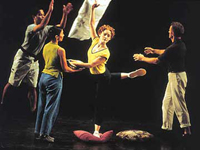
Documenting Performance-Based Art
Evidence of Movement :: July 10-October 7, 2007 :: The Getty Center :: Getty Research Institute Exhibition Gallery.
In the collecting and display of art, performance has posed strong challenges to established notions of both the art collection and the archive. Unlike painting or sculpture, performance-based art exists without an original, tangible, and self-contained object. Because of this, archival material such as documentary photography, film and video, and artists' notes and sketches are often studied, collected, and exhibited as works of art. Nearly every medium imaginable has been used by artists to document performance work, including photographs, videos, audio recordings, notes, drawings, paintings, scores, posters, prints, books, objects, and sculptural remnants.
Drawn primarily from the collections of the Research Library at the Getty Research Institute, this exhibition surveys the great variety of creative means by which artists have used durable and traditional media to document performance-based art. These attempts to transpose the dynamic and experiential qualities of performance into documentary and archival media have influenced the field of art as a whole, and have opened vital avenues of exploration. Artists featured in the exhibition include John Baldessari, Gunther Brus, Allan Kaprow, Mike Kelley, Suzanne Lacy, Paul McCarthy, Hermann Nitsch, Robert Rauschenberg, Carolee Schneemann, Tony Oursler, Yvonne Rainer.
Posted by jo at 02:35 PM | Comments (0)
ACTIVE AGENTS
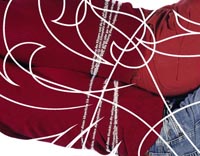
The Blurring of Borders
ACTIVE AGENTS :: Maria Hahnenkamp, Zilla Leutenegger, Ulrike Lienbacher, Manuela Mark, Mara Mattuschka / Chris Haring / Gabriele Szekatsch, Eva Stern :: Opening: September 22, 2007, 10 a.m. :: From September 25 - November 24, 2007; Tue - Fri 2-6 p.m., Sat 10 a.m. - 2 p.m. :: Location: Kunstverein Medienturm, Josefigasse 1, 8020 Graz, Austria :: Coproduction: steirischer herbst & Kunstverein Medienturm.
The relation of nature and technology has obviously shifted within the last years. The body increasingly is pressurized by a technology which more and more lets the borders of the body blur. Technical objects and procedures define to an always stronger extent what we understand as our subjectivity. Which potential of acting must already be allowed technical objects? Which "images" of the subject can yet be detected?
ACTIVE AGENTS analyses the current techno culture by asking how the differentiation between the technical and the social has been blurred and in what way this suspension of an ontological border also has to be described as political project. In this respect, the exhibition handles also the preconditions, interfaces and potentials of acting in the frame of extended body dispositivs, thus also questions of models or even utopias of coexistence.
Interventions in the frame of ACTIVE AGENTS:
Will (I, II)
Ulrike Lienbacher
Period: 16.08. - 07.10. 2007, Mon - Sun 12 - 7 p.m.
Location: Koje Medienturm, QDK/MQ Vienna, Museumsplatz 1, 1070 Vienna, Austria
The Legal Errorist
Mara Mattuschka / Chris Haring
Period: 11.10. - 09.12. 2007, Mon - Sun 12 - 7 p.m.
Location: Koje Medienturm, QDK/MQ Vienna, Museumsplatz 1, 1070 Vienna, Austria
Image: Maria Hahnenkamp, "O.T." (from the series "Cut-Out"), 2007. C-print on Dibond, 72 x 92 cm. Courtesy: Galerie Krobath Wimmer, Vienna
Posted by jo at 11:21 AM | Comments (0)
Digital Art Weeks 2007: Place Relations

PLACE RELATIONS: A special exhibition has been installed at Der Kunstraum Walcheturm in Zurich, Switzerland for Digital Art Weeks 2007 :: Participating Artists: Eteam (DEU), John Craig Freeman (USA) and Will Pappenheimer (USA) :: July 10 - 14; open daily from 14:00 - 20:00 :: Exhibition Host: Patrick Huber, Kunstraum Walcheturm.
The import of location in place-based artworks represents a set of relations that become visible as they are affected or reconfigured. The artists in this exhibition explore the potential of public space, geographic territory, architectural location, social relations, online informational media, and virtual 3D worlds to form situational works. Their methods include participatory performance, field documentation, new media interactivity and mixed media installation. Results emerge as a hybrid reading of community venture, memory map, psychogeographic inquiry and information aesthetics. The works are situational in revealing the conditions or potential of place. They appear momentarily, as a shift in the relations of everything that blends into city life, distant landscape, or the event-stream of global digital space.
International Airport Montello by eteam: On top of chosen public or private terrain, we are visualizing a "possibility" one, that is usually suggested or challenged by the borders and limits of the place and its environment itself. The ability of a possibility to exist within a specific place is of temporary emergence. It usually lasts as long as it takes to realize that the possibility is possible. In our work, this "realization" often happens in a very practical and participatory way. Everyone engaged in the piece has the opportunity to experience a certain probability within the piece's possibility. All 3 projects (1.1 Acre Flat Screen, The Paradox of the 10 Acres Square and International Airport Montello) are based on random pieces of land we bought on ebay.
Imaging Place by John Craig Freeman (aka JC Fremont): Imaging Place is a place-based, virtual reality art project that combines panoramic photography, digital video, and three-dimensional technologies to investigate and document situations where the forces of globalization are impacting the lives of individuals in local communities. The goal of the project is to develop the technologies, the methodology and the content for truly immersive and navigable narrative, from real places. The project has been under development since 1997 and includes work from around the world. The interface leads the user from global satellite images to virtual reality scenes on the ground. Users can then navigate an immersive virtual space.
Join JC Fremont at Emerson Island in Second Life for the opening reception on Tuesday July 10 from 14:00 - 16:00 CEST (5:00 - 7:00 AM PDT Linden Time). ">SLurl tag.
Public Mood Ring by Will Pappenheimer: Public Mood Ring is a combined internet and spatial installation displaying the emotional condition of public news stories as color hue. It is based on the wearable "mood ring" which chemically changes color according to body temperature. A series of animated web pages allow users to pick a news story, a cultural color model and to observe the process of the search engine. The artwork responds to participants news concerns and recalibrates the color of exhibition space with architectural LED lighting. The shared experience is the gift of the remote participant and an immersive color representation of current world events.
Participate in a live performance of the Public Mood Ring during the the opening reception of the exhibition on Tuesday July 10 from 14:00 - 16:00 CEST (8:00 - 10:00 AM EST) or for the duration of the exhibition.
Posted by jo at 10:40 AM | Comments (0)
STREAMFEST: SALENTO NEW MEDIA FESTIVAL

StreamFest :: July 26-28, 2007; 8pm :: Quartiere Fieristico, Galatina (Le)
StreamFest is the first international new media festival in South-East Italy, an event whose aim is to present the creative applications of the most advanced technologies in the Salento, an Italian region selected as a special location for the European cultural summer. It will host a sample of interactive installations and audiovisual experimentations by some of the forerunner of a research path which tends to conjugate images and music through the creation of VJ sections stretching beyond the usual modalities of live concerts and music videos.
The first edition of the StreamFest looks towards the future of the Salento region with the awareness that it is possible to conjugate technological development and the love for nature harmonizing the electronic nights of the StreamFest and the days spent by the sea in the typical Salentinian mood. The party atmosphere traditionally characterizing the Salentinian nights can be translated in a contemporary note through the multisensorial partecipation and emotional involvement which are the aim of the artistic researches about multimediality.
Among the internationally acclaimed protagonists, the StreamFest will present the already historical HASCII CAM from Jaromil, the free radio war experience of Cecile Landman with SteamTime, the ambient installation of Scenocosme, the Italo-austrian duo with Salentinian roots, Casaluce-Geiger, the music of North-Europe with Lacklaster from Finland and Felix Randomix together with Carsten Schultz from Germany. The Italian VJ scene is represented, among others, by Flxer, Kinotek and Claudio Sinatti. During the StreamFest, a project created by the Master in Digital Environment of the NABA-Milan will also be presented.
StreamFest is a project of the Cultural Association 'sud-eStream' (art director Antonio Rollo, with the consulency of Carlo Infante and the Performing Media Lab, Luca Barbeni from the Share Festival, and Giulia Mainent) in collaboration with Ente Fiera Salento S.p.a, supported by Regione Puglia, and with the patronage of the Academy of Fine Arts in Lecce and ITAS 'G. Deledda' in Lecce.
The VJ and Dj sets of the StreamFest are going to be populated by the new authors of the interactions between sound and image, who, like shamans, manipulate electronic visions for emotionally involved spectators in search of new proposals.
Posted by jo at 08:13 AM | Comments (0)
July 06, 2007
ProvFlux 2007
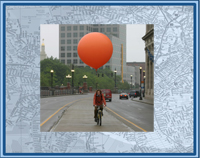
Carnival | Conference
July 12-15, 2007 :: Providence, RI :: Part carnival and part conference, ProvFlux brings together artists, theorists, urban adventurers and the general public to share their visions of what the city can be, and to take action to make it a reality. The simple premise behind ProvFlux is to create an environment of positive activity, and to continue expanding upon the ideas of what one can do in their city. It exists to invite people from all walks of life to meet on the common ground that is our city streets, in an unjuried, completely free and 100% participatory environment.
One event amongst many is An Atlas, a traveling exhibition of artists working with “radical cartography”—a practice that uses maps and mapping to promote social change. The 11 participating artists, architects, and collectives take on issues from globalization to garbage and explore the map’s role as a political agent. Works include Ashley Hunt’s intricate diagram of the social effects of the global prison-industrial complex; the Center for Urban Pedagogy’s mapping of the people who make and manage the “garbage machine” in New York City; Trevor Paglen and John Emerson’s route map of CIA rendition flights; and Invisible 5’s audio tour of the “toxic landscape” along Interstate 5 in California. Other participating artists include: An Architektur, Institute for Applied Autonomy, Pedro Lasch, Lize Mogel, Brooke Singer, Jane Tsong, and Unayyan.
Posted by jo at 02:36 PM | Comments (0)
Visionary Landscapes: Electronic Literature Organization 2008 Conference
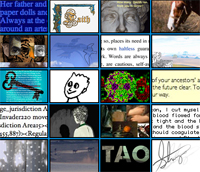
Call for Proposals
Visionary Landscapes: Electronic Literature Organization 2008 Conference :: May 29 - June 1, 2008 :: Vancouver, Washington :: Deadline for Submissions for Presentations: November, 30, 2007 :: Notification of Acceptance: December 30, 2007 :: Sponsored by Washington State University Vancouver & the Electronic Literature Organization :: Dene Grigar & John Barber, Co-Chairs (website, coming August 8).
Producing a work of electronic literature entails not only practice in the literary arts but sometimes also the visual, sonic, and the performative arts; knowledge of computing devices and software programs; and experience in collaboration, interdisciplinarity, and hybridity. In short, electronic literature requires its artists to see beyond traditional approaches and sensibilities into what best can be described as visionary landscapes where, as Mark Amerika puts it, artists "celebrate an interdisciplinary practice from a literary and writerly perspective that allows for other kinds of practice-based art-research and knowledge sharing."
To forward the thinking about new approaches and sensibilities in the media arts, The Electronic Literature Organization and Washington State University Vancouver's Digital Technology and Culture program are inviting submissions to the Electronic Literature Organization 2008 Conference to be held from May 29 to June 1, 2008 in Vancouver, Washington.
"Visionary Landscapes: Electronic Literature Organization 2008 Conference" is interested in papers that explore forms of digital media that utilize images, sound, movement, and user interaction as well as––or in lieu of––words and that explore how we read, curate, and critique such works. Topics may include:
• New, non-screen, environments for presenting multimedia writing and /or electronic literature
• Research labs and new media projects
• Strategies for reading electronic literary works
• Curating digital art
• Innovative approaches to critiquing electronic literature
• Emerging technologies for the production of multimedia writing and /or electronic literature
• Building audience for new media literary works and writing
• Digital, literary performances
• Publishing for print or electronic media connecting literature and the arts through common archiving and metatag strategies
• Artistic methods of composition used in intermedia storytelling (improvisation, collaboration, sample and remix, postproduction art, codework, hactivism, etc.
In conjunction with the three-day conference, there will be a juried Media Arts Show. Along with prizes for the most notable work, selected artists will be awarded bursaries to attend the conference featured at the show. Submission guidelines will be posted beginning August 15, 2007 on the conference website.
The keynote speaker is internationally renown new media artist and writer, Mark Amerika, named a "Time Magazine 100 Innovator." His artwork has been exhibited at the Whitney Biennial, the ICA in London, the Walker Art Center, and the Denver Art Museum and has been the topic of four retrospectives. Amerika is also the author of many books, including his recently published collection of artist writings entitled META/DATA: A Digital Poetics (The MIT Press), founder of the Alt-X Network, and publisher of the electronic book review. He currently holds the position of Professor of Art and Art History at the University of Colorado at Boulder.
Vancouver, Washington, located in the Pacific Northwest just across the Columbia River from Portland, OR, is about a six hour drive south of Vancouver, Canada and three hours south of Seattle, Washington. The conference day events will take place at Washington State University Vancouver, a Tier One research Institution built in the foothills of the Cascade Mountains with views of Mt. Hood and Mt. Saint Helens. The official conference hotel is the Hilton Vancouver located in downtown Vancouver, Washington with easy access to restaurants, bars, and evening conference events. Special rates have been negotiated for conference attendees. A conference shuttle will take attendees to and from the campus daily. The recommended airport is PDX at Portland, which is about a seven minute drive to downtown Vancouver, WA.
The cost of the conference is $150; graduate students and non-affiliated artists pay only $100. Conference registration covers access to all events, the reception, some meals, and shuttle transportation.
For more information, contact Dene Grigar at Grigar[at]vancouver.wsu.edu.
Posted by jo at 02:23 PM | Comments (0)
Régine Debatty Interviews
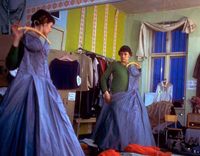
Christine Hill
"[...]Do you perform or role-play with Volksboutique? How do you differentiate one from the other?
It is good that the the word "performative" has entered the general art vocabulary, because it rescues work like mine from being labeled as Performance Art. I am extremely averse to theater, because I don't want to see a simulation of life. I want life. I want things real and in real time. And there is always going to be that unfortunate leap the mind makes when hearing the phrase "performance art" that conjures the stage whisper, or someone setting themself on fire. So I don't consider myself to be performing in the sense that we understand "acting" or staging. But I DO find that the entire thing is about performance, in terms of what in German is the word Leistung. And I do have a certain public persona that is in the work (and probably in my teaching as well). It is a part of my own personality, not something that is assumed, but it is also specific to certain projects that contain an extroverted element. Initially, my labors in the Volksboutique were specifically about pointing directly to the fact that this was an occupation. Something all-consuming, that required a sweat to be broken. And about clarifying that my own person/a was the guide through this set of ideas. This is also a way of addressing accountability and responsibility. Projects of mine require participation of various levels by viewers. How much they can access has in part to do with how they approach me as the representative of any given work. I feel this is a fair exchange, similar to any in a shop transaction..." From Régine Debatty's Interview with Christine Hill, we-make-money-not art.
Posted by jo at 01:48 PM | Comments (0)
Art makes a scene on Second Life
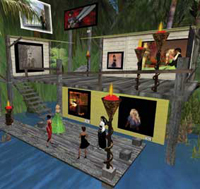
"One of the Best Places for Artists, Curators and Dealers to Meet"
With over 7m registered users, Second Life—an online virtual world complete with land, residents and a growing economy—is developing one of the largest art communities on the internet. The site’s money-making and marketing potential to reach a new, younger audience is already being tapped by major corporations such as BMW, Adidas and Sony, which all have a presence there. Entire countries have also established virtual outposts. The Maldives was the first nation to open an embassy on Second Life’s “Diplomacy Island”, where visitors can consult an ambassador about visas, trade and other consular issues. It was quickly followed by Sweden, while online embassies for the Philippines and Macedonia are under development.
Museums, universities and non-profit organisations are getting involved as well. In the art world, the Andy Warhol Foundation has helped fund exhibitions and projects in Second Life, such as “Mixed Realities”, an annual juried competition set up in 2004 with Turbulence.org, a group that has supported art on the internet since 1996, to commission five new online art works. Each winning proposal receives $5,000." Continue reading Art makes a scene on Second Life: The online virtual world is becoming one of the best places for artists, curators and dealers to meet, by Helen Stoilas, July 4, 2007, The Art Newspaper.
Posted by jo at 12:10 PM | Comments (0)
[iDC] City as Social Network: Eric Gordon
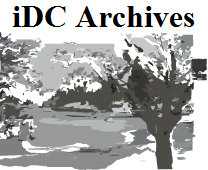
Participation Equals Surveillance
Hi everyone. My name is Eric Gordon – I’ve been watching this list for some time but I’ve made only a few contributions. Perhaps as a means of forcing my involvement, Trebor has asked me to moderate a discussion on the topic that has lately occupied most of my time – place-based social media and its implications for privacy, public space, and democratic engagement.
Following the recent conversation about Feedburner, I want to consider how that discussion might extend to physical communities (neighborhood, organization, city) that are enabled / bolstered / fortified by social web media. Many community groups and neighborhood organizations are using digital networking technologies to foster community interaction (http://www.ibrattleboro.com/). And of course, what is widely known as citizen journalism plays into this as well – placebloggers and Community Media organizations tend towards hyperlocal networked content (http://www.cctvcambridge.org/) with an aim towards reinforcing existing geographical connections.
The processes that bind non-geographical communities in networks are similar to those that are binding geographical communities – shared interests, practices, goals, etc. However, unlike traditional online communities that have a basis in anonymity, digitally annotated physical communities often rely on the full disclosure of identity for their functionality. For instance, when it comes to neighborhood issues – it is important to know one’s real name and location.
And as city governments are seeking ways to adopt “web 2.0” technologies into their existing “citizen management” projects, the lack of anonymity and the simple traceability of social actions open up new concerns. Social media tools have the capacity to significantly expand participation in local governance, but they also have the capacity to trace citizen behavior and map social trends. Cities are interested in this technology for the same reason that corporations are – it offers valuable user data. Politicians can survey the concerns of their constituency; agencies can identify problems in neighborhoods; and law enforcement…well, there are many scenarios possible. It can also be turned around: citizens can have greater access to their politicians, and government proceedings can at least have the impression of transparency.
While the conversations on this list have devoted considerable time to corporate surveillance, the question not often asked in this context is what should be made of local surveillance – from the people in one’s neighborhood to city governments? In the wake of connectivity, discourse and collaboration, there is always documentation, processing and interpretation. From neighborhood chatrooms to local annotated mapping projects to virtual town hall meetings, participation equals surveillance – for better or for worse.
When I consider a digital future in which I want to live – it includes networked access to my neighborhood services, communities, city government and public spaces. However, there is little possibility for that to take place outside of the proliferation of data that would make communities vulnerable to excessive internal and external management. And as citywide wifi and mobile web devices proliferate, the outlets for that recycled data expand. At the same time, American cities, like corporations, are glomming onto digital media because of its populist resonances. They are paying attention to online neighborhoods and seeking to aggregate that data into meaningful information. The ideology of digital media – as evidenced in the phrases “participatory media” and “user-generated content” – is accessibility. Digital media directly aligns the rhetoric of progress with the rhetoric of populism. Social web media makes explicit what has only been implied in the recent rhetoric of city governments – that anyone, regardless of social position, can participate in the ordering of city experience and politics.
From cities to towns to neighborhoods, the populist promise of social web media is transforming the nature of public space and civic participation. I am referring only to the American context, because that’s what I know, but it would be great to engage in comparative dialogue in order to better understand the scope of how these technologies are being implemented in official or unofficial capacities to change perceptions of cities and city life, not to mention public space and community engagement.
I suppose I’ll leave it at that for now. I look forward to the conversation.
Eric
iDC -- mailing list of the Institute for Distributed Creativity iDC[at]mailman.thing.net http://mailman.thing.net/cgi-bin/mailman/listinfo/idc
List Archive:
http://mailman.thing.net/pipermail/idc/
iDC Photo Stream:
http://www.flickr.com/photos/tags/idcnetwork/
Posted by jo at 11:13 AM | Comments (0)
Nina Czegledy reports on Media Forum 2007
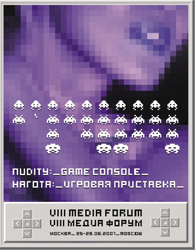
Nudity:_Game Console_
Between June 25-28, Media Forum, Moscow in collaboration with the Moscow International Film Festival, presented Nudity/Game console - a series of events including a Vito Accoinci retrospective, round table discussions and a video art competition. The theme of this year was: Nudity/Game console. The ERA Foundation hosted the Media Forum events in their centrally located, elegantly renovated gallery space.
In this report I would like to focus on the round table discussions - especially as the majority of the presenters happened to be women working with research & practice in digital fields/communities. Instead of lengthy descriptions, links are provided below for further information.
"Cultural cooperation online", the first discussion on June 26th was presented by Angela Plohman, content developer of Labforculture. The organization provides extremely useful tools for those in the arts who wish to collaborate across borders. The constructive, practical value of this information and knowledge platform was very much appreciated by the audience as attested by the numerous questions and comments.
On June 27, Anne Nigten of V2 lectured on "Research and development in the interdisciplinary field from an art perspective" followed by Dmitry Bulatov on "The third modern - denuding the media. The technobiological art work." Last but not least Margarete Jahrman showed us "Pong Dress" and Ludic Society. All of these presentations were very well received with lively Q&A periods.
Next day, June 28, "Super-Embodiment of Woman Artists in Media Arts" was presented by Irina Aristarkhova, Nina Czegledy and Elena Kovylina. Irina noted in her introduction that "Nudity and the Nude - have become key issues in contemporary art, theory and politics. Women artists face what Foucault called 'hysteriarization of female body', while men artists face an issue of 'absent male body' (Kelly Oliver) and respond to it with various strategies. One might argue that both Western and Eastern European women artists have exhibited 'too much body', and to a certain extent find it difficult to leave "body" behind. However, we rarely discuss what impact socialist gender policies and practices have had on this process within aesthetics. If performance art leaves us with legacy of 'too much body' - 'super-embodiment', - one wonders of it morphs into (new) media art as question of 'machine' / 'cyborg' embodiment and its identity."
In the course of our presentations both Irina and myself emphasized that feminism and gender issues can not be separated from the particular history of the region. Lack of clarification of this issue leads to numerous misconceptions and miscommunication. Case histories of media art were presented including "I am a robot" by Boryana Dragoeva Rossa (Bulgaria) and "Reality Resonance" by Erika Katalina Pasztor (Hungary), followed by the outstanding Russian performance artist Elena Kovylina, showing her "Pick a Girl" video performance featured at the Sydney Biennale 2006. The questions and comments at the end of our panel revealed that controversy and strife are still embedded in this discourse.
The schedule left room for us to visit some artists studios, participate in the mega-retrospective by Oleg Kulik and Vinzavod and old factory converted into a mixed use art center and luxury boutiques - where hopefully the Media Art Lab will have its future home. There is so much more including Art4 the private contemporary art museum, Moscow Rolls Royce, the electroboutique, traffic jams, night life etc. etc -worth a visit!
nina [via Spectre]
Posted by jo at 10:37 AM | Comments (0)
070707 UpStage
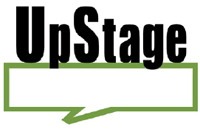
Online Performance Festival
The 070707 UpStage Festival kicks off in less than 24 hours, live online and at the New Zealand Film Archive in Wellington, NZ. From 2.30 to 11.30 pm NZ time (10:30 pm Friday, July 06, 2007 EST; find your local time), on Saturday 7th July, performances created in UpStage by artists from around the world will delight, entrance, engage, baffle, amuse and rock you!
070707 UpStage Festival has all the information, including links to find your local time for each show, and 15 minutes before each show there will be a live link directly to the stage for that show.
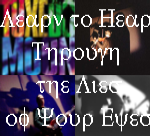
Learn to Hear Through the Lies of Your Eyes: The Cyberforming Hybridization of Tuxedomoon: Devised and performed by Miljana Peric, Teodora Peric and Ana Markovic, in Belgrade, Serbia. This cyberformance addresses the position of the contemporary musician in a relation to predominantly scopophilic regime of the Artworld based on information technology. Standard phonocentrical practice will be replaced with poetocentrical praxis by quoting, paraphrasing and mixing up the lyrics of Tuxedomoon. Instead of counterpoint techniques, it involves the counter-soundpointless tactics, which symbolise the protest against disregarded role of music in cyberformances in general.
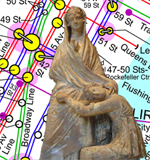
Isis: for my mother: Devised and performed by Marlena Corcoran, with Tamiko Thiel. Loss, fragmentation, searching … the inevitability of losing one’s mother, and the ways that we cope. A collage of medical body fragments - x-ray, sonic graph, surgical photo, ultrasound image and others – hints at a female person, but there’s always something missing, and something left over. Marlena is based in Munich, German.
And many more performances...
Posted by jo at 10:08 AM | Comments (0)
July 05, 2007
Interferences
Interferences ... is an interactive installation created by Matteo Sisti Sette and Maribel Pozo which consists of a back projection screen showing an artificial life system which is sensitive to electromagnetic waves emitted by users mobile phones.
In its ‘natural’ state, image and sound are in constant evolution, moving and growing as if alive. Their growth and evolution is altered in the presence of electromagnetic waves.
This work tries to draw attention to a phenomenon whose physical and material relevance we tend to ignore. Little is known about the effect these radiations produce on human body. Maybe they are not dangerous. Many elements of our environment are not, yet they concern us because of their aspect or noise or odour. If we couls [sic] see, or hear the amount of energy which is carried by electromagnetic waves and which passes through our body, would we behave the same way as we do?
The installation is created with Pure Data and Processing. [posted by Garrett Lynch on Network Research]
Posted by jo at 07:19 PM | Comments (0)
Antony Gormley
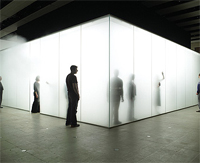
The Body in Space
Antony Gormley at The Hayward Gallery, Southbank Centre, London until August 9, 2007.
"The body is our first habitation, the building our second. I wanted to use the form of this second body, architecture, to make concentrated volumes out of a personal space that carries the memory of an absent self, articulated through measurement … Bodies and buildings, cities and cells, monuments and intimacies, each of the “rooms ” in (allotment) is someone’s, is connected to the moving body of an individual, alive and breathing."
'Architecture is supposed to be the location of security and certainty about where you are. It is supposed to protect you from the weather, from darkness, from uncertainty. Blind Light undermines all of that. You enter his interior space that is the equivalent of being on top of a mountain or at the bottom of the sea. It is very important for me that inside it you find the outside. Also you become the immersed figure in an endless ground, literally the subject of the work.’ - Antony Gormley
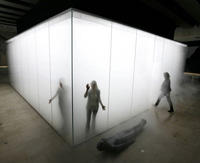
From the exhibtion website:
Taking the body as its point of departure, the exhibition is an invitation to embark on a journey through different kinds of space. New works include Blind Light: lose yourself in light and vapour in this cloud-filled glass room that is cold, wet and disorientating; a spectacular series of suspended figures in light-infused webs of steel; and a colossal 27-ton structure, Space Station, that tilts precariously, dominating the gallery space.
The exhibition extends beyond the confines of the gallery with Event Horizon, an ambitious urban artwork featuring around 30 sculptural casts of the artist’s body on rooftops and public always across central London, subtly punctuating the city skyline. Spanning outwards from The Hayward, all the figures face towards the gallery’s three sculpture terraces, which form the main viewing platforms for the project as a whole. [via pruned]
Posted by jo at 06:06 PM | Comments (0)
White Glove Tracking
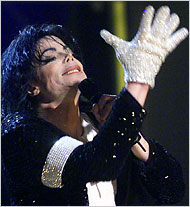
"...Michael Jackson-watching, with Entertaining Results"
"The White Glove Tracking project was created by Evan Roth and Ben Engebreth, with the backing of the art-and-technology groups Rhizome and Eyebeam. Web-surfing volunteers were invited to view frames of Michael Jackson's legendary performance of "Billie Jean" on a 1983 television special and pinpoint the location of Mr. Jackson's white glove.
The glove trackers tackled the job just for fun, finishing the job in 72 hours back in May thanks to a surge of traffic from Digg and other sites. The data they produced is now available online and has already been put to some highly creative uses. My favorite is this clip by Zach Lieberman, in which the "Billie Jean" video has been automatically cropped to focus obsessively on the glove. The result is something like watching "The Glove, Live on Stage, Wearing Michael Jackson." (Frames with no glove, like those at the beginning, are black.)" From Tracking Michael Jackson's Glove Online: A research project roped thousands of volunteers into some Michael Jackson-watching, with entertaining results, by David F. Gallagher, Bits (NY Times blog)
Posted by jo at 01:21 PM | Comments (0)
LABworkshops: Second Life & Chiptunes
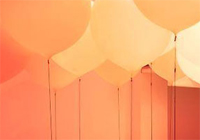
Call for Participation
ENTERING THE TERRITORIES OF SECOND LIFE :: July 17 - 21, 2007 :: Deadline: July 8, 2007 :: Registration :: Fee: 50 :: CHIPTUNES - 8BIt MUSIC :: July 26-27, 2007 :: Deadline: July 16, 2007 :: Registration :: Fee: 25 :: Working language for both: English and Spanish :: @ the workshop premises of the LABoral Centre for Art and Creative Industries.
ENTERING THE TERRITORIES OF SECOND LIFE: Second Life (SL) is an online virtual world currently inhabited by over six million "residents". The workshop hosted in Laboral explores SL as a platform for art expression, activism and critique. It will be led by a machinima professional, two media artists and a programmer who work on SL on a practical and theoretical level using it as an ideal platform to share ideas and to perform. Participants will learn through collaborative work how to make machinimas, how to write basic scripts and how to use SL as a platform for social action and artistic expression.
Workshop led by: RICARD GRAS (ESP) is an artist, producer and director of machinima Europe Board. He explores new creative uses for technologies and relationships between art and the media. In 2003, he founded LA-INTERACTIVA, one of the companies that are officially in charge of the development of SL.
KRISTIAN LUKIC (SERBIA) is a writer, artist and a cultural and game researcher. He is a program manager in New Media Center - kuda.org and the founder of Eastwood - Real Time Strategy Group and also of Napon - Institute for flexible culture and technologies.
ILIAS MARMARAS (GR) is a new media artist and a leading member of the international group Personal Cinema. He has been working in gaming environments and game art since 1999.
YANNIS SCOULIDAS (GR) is a technical director, administrator and programmer of Personal Cinema and specialist in software and hardware.
CHIPTUNES - 8BIt MUSIC
8bit sound and music is a distinctive feature of early videogames, and has become a seminal contemporary music style utilized by artists and DJs in engaging live audiovisual performances and remixes. This workshop will bring together creators from US and Spain who will work with young people to create music using Gameboys. The workshop will close with an evening of Chiptunes performances with sounds by the artists, the workshop participants and visuals by media artists Entter.
Workshop led by: HAEYOUNG KIM (BUBBLYFISH) (KO) is a sound artist and composer who explores the textures of sounds and their cultural representation. Her work has been presented in art venues, clubs and new media festivals around the world.
CHRIS BURKE (GLOMAG) (USA) has been making 8bit music since 2001. He has performed in many countries and his music has played in films, on television and on the Internet. The machinima series "This Spartan Life", features his music as well as other 8bit artists and is featured in Gameworld.
RABATO(ESP) composes music with the famous software Littlesounddj created by Johan Kotlinski for a Nintendo Gameboy consoles. He is the co-founder of microBCN and has participated in festivals and concerts in various cities.
YES, ROBOT (ESP) mix Gameboy sounds with other instruments like synthesizes, samples and toys modified by themselves. They are founding members of the 8bit collective microBCN.
ENTTER(ESP) is formed by Razl Berrueco and Raquel Meyers. Entter was formed to create a collective space for the expression of the common restlessness felt by many creative people in the interactive media art field. Their fields of research include AVperformance, installations, non-linear narrative, videogames, interfaces, experimental music, VJing and net.art.
Concept of workshops: Daphne Dragona, independent new media arts curator, Athens Carl Goodman, Deputy Director and Director of Digital Media,Museum of the Moving Image, New York
Organised by: LABoral Centre for Art and Creative Industries Director: Rosina Gsmez - Baeza Universidad Laboral s/n, 33394 Gijsn, Asturias - Spain T. +34 985 185 577 F. +34 985 337 355 labworkshops@[at]aboralcentrodearte.org
Posted by jo at 12:35 PM | Comments (0)
TEST_LAB: PLAY!
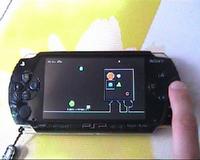
European Art Graduation Projects 2007
TEST_LAB: PLAY: European Art Graduation Projects 2007 :: July 12, 2007, 8:00 p.m. :: V2_Groundfloor, Eendrachtsstraat 10 , Rotterdam :: Free entrance :: Streamed Live :: Invited speakers: Simon Jones (Human-Computer Studies, University of Amsterdam) and Dirk Paesmans and Joan Heemskerk (jodi.org). [Related; Essay by Josephine Bosma.]
Play as a form of social interaction has a rich tradition in various branches of the arts. But it was only recently that human-centered-technology designers realized play offered interesting new approaches and techniques for the development of their field. This brings them together with contemporary artists who explore play by experimenting with a wide range of (often wearable) human-machine interfacing technologies. Such experiments often combine a strong DIY attitude toward technology design with a desire to take advantage of people's naive or intuitive understanding of technology through play. In TEST_LAB: PLAY! the audience and participants will test and discuss the approaches and techniques used to implement play. They will also discuss the broader context of the demonstrated work.
TEST_LAB: PLAY! will feature a selection of the best European electronic-art graduation projects of 2007. The pieces have been selected according to originality and quality, and especially the way they use the concept of play - that is, the playfulness evoked by the work. At TEST_LAB: PLAY! these projects will be demonstrated, tested, and discussed among makers, audience and experts.
Demonstrations:
- Dobrze by Dorota Walentynowicz (Interfaculty Image and Sound, The Hague)
- Block H. by Faith Denham (Goldsmiths, University of London)
- CollecTic by Jonas Hielscher (Media Technology, Leiden University)
- Wi-Fi Straitjacket by Gordan Savicic (University of Applied Arts Vienna)
- Paraphernalia by Nancy Mauro-Flude (Piet Zwart Institute, Hogeschool Rotterdam)
TEST_LAB is a bimonthly public event hosted by V2_, Institute for the Unstable Media, that provides an informal setting for the demonstration, testing, presentation, and discussion of artistic research and development (aRt&D).
For more information, please contact Michel van Dartel (michel[at]v2.nl,
+31-10-206-7272).
Posted by jo at 11:47 AM | Comments (0)
Intermedia Art Show
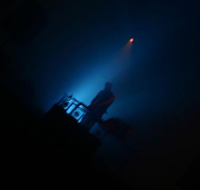
Public Performedia Collective
Intermedia Art Show (a collaboration between the International Festival of Contemporary Art, Experimental Art I.M.A.N. and Gallery Zero Berlin) :: Performance: July 7, 2007 ; 8:00 pm :: Artists: Alexandre A.R. Costa & Jorge Fernando dos Santos: Public Performedia Collective & Lucky Zulu + Hugo Paquete (sstfm) :: Portugal.
Public Performedia: This Project combines a live performative act, done In-Situ (City of Berlin), with a post-concert within the realm of electronic music / Experimental Intermedia Art Show. This Performance that begins a continuous process, and that culminates in an Intermediate experimental art show, will be established by the contextualization of the artists and their performative actions within emblematic buildings of Berlin (interiors and / or external sites).
Project Description (Live Art Work): Immobility, silence and disguises are key - concepts in this process, developed through an interrogative perspective of the daily social paradigm of our days in the deep of the wild "Business world", metaphorically referenced by the elements that these are holding and let fall and for the movement of the city itself, collected in the show in video audio and worked in digital Interfaces in real time.
Conclusion: Intermedia Art Presentation (Post-Live Art Work in Berlin):
In conclusion there are clearly two phases in question: the first one happens in a perspective of an investigation In-loco and In-Situ (during which Video Audio recordings are performed with the participation of audiences and the performing intervention of the Artists). The second moment happens with the Intermedia Presentation / Concert.
The video audio registrations on the mentioned action are worked in real time in an audio-visual/ Intermedia presentation (a minimal performing proposal and a subscription through the universe of electronic music) as exemplified by the following registrations included in the demonstration DVD herewith.
www.iman-arte.blogspot.com
www.publicperformedia.blogspot.com
Posted by jo at 11:23 AM | Comments (0)
Pioneering Second Life artist to inspire Australian artists
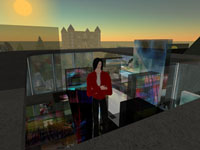
Brad Kligerman
On 12 July, the Australia Council for the Arts, in partnership with the Australian Broadcasting Corporation (ABC), will host its first ever artist forum in Second Life. The in-world event, to be moderated by ABC's Sunday Arts reporter / producer Fenella Kernebone, is for the Australia Council's inaugural Second Life artist residency.
In an open forum at 7 pm (EST) on ABC Island, Paris-based artist and architect Brad Kligerman - one of the first artists in Second Life to complete an in-world residency - will present his work, discuss ideas and answer participants' questions. [Videos and more here.]
Brad, an architect and teacher, completed his 11-week residency with US-based Ars Virtua a new media centre and gallery in Second Life, where he questioned the idea of materiality in the rendered environment and the nature of image. Australia Council chief executive officer Kathy Keele said the partnership with the ABC was a great fit with the Australia Council's Second Life initiative. 'The ABC was the first Australian media organisation to establish a presence in Second Life and we are excited about working with them on this project.'
'We hope that Australian artists gain valuable insight from Brad Kligerman's successful art interventions in Second Life and that they will be inspired to create innovative works in-world that will place them at the forefront of this groundbreaking practice,' Kathy Keele said.
The Australia Council has also set up an artist's forum in Second Life for artists looking for other artists with whom to collaborate. The moderated artists forum can be found at ABC Island and the Australian Film, Television and Radio School (AFTRS) Island, Esperance.
Opened in February 2007, ABC Island explores new and different ways to present content to its audiences. As well as creating social spaces for Second Life visitors, the island showcases Australian talent and creativity in an innovative way.
Places for the 12 July Second Life event are limited. To register email slrsvp[at]ozco.gov.au with your Second Life Avatar name. The event will be streamed live at http:\slcn.tv. A vodcast of the event will also be available on the ABC Sunday Arts website. Sunday Arts screens Sundays at 5.00pm.
The Australia Council's Second Life residency will enable a team of up to three artists, including a writer, musician / sound artist and digital visual media practitioner to collaborate on the development of inter-disciplinary artwork in Second Life. The project, which will take place online, will require the artists to explore the possibilities of literary, music / sound art and real time 3-D arts practices within the virtual realm.
The residency is open to Australian citizens and permanent residents. Applications close on 27 July 2007. For more information visit www.ozco.gov.au/rez
For more information on Ars Virtua and Brad Kligerman visit www.arsvirtua.com. Media enquiries - Victoria McClelland-Fletcher, communication officer phone 02 9215 9008 or 0400 808 013 or email v.mcclelland[at]ozco.gov.au.
Posted by jo at 11:13 AM | Comments (0)
okno / Network Summer
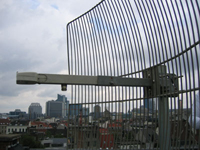
Invitation to Participate
okno / network meetings :: July 12-13, 2007 :: okno HQ, koolmijnenkaai 30-34, 4th floor, 1080 BXL :: entrance free ::
This summer, okno (code31, so-on, riseau citoyen) will take a look at artistic networks. In a series of meetings, we share our research and collaborate in hands-on experiments with wireless technology. Whether you're a visual artist, writer, musician, coder, hardware developer or just have a keen interest in wireless networks, we would like to invite you to come over and join us.
Together, we'll look for new ways of using networks, investigate their artistic value and their social and geographical context. Wireless technolgies are affordable and powerful instruments. By learning how to make and use them, we can break out of the limits imposed by corporate and government-regulated restrictions. //meh In our hands-on experiments, we'll be builing antennas, setting up the network and use it for audio and video.
July 12, 2-7pm :: an introduction to the Reseau Citoyen-network and how to work with it by Cidric Thernon - Reseau Citoyen is a Brussels project for a user-run wireless network via wi-fi; free of big operators, run by the people for the people. Riseau Citoyen is not an organisation, it's much more a phenomenon. Beside its technological aspects, Riseau Citoyen is a vector for ideas. Community network projects are coordinated by citywide user groups who freely share information and help using the Internet. They often emerge as a grassroots movement. Reseau citoyen is run on a voluntary basis. Reseau Citoyen has a distinct ideological approach in putting up a free and open network. The volunteers provide the technological expertise and in a collaborative spirit make it available to the inhabitants of Brussels.
Okno tries to complement the social and technological infrastructure from a cultural point of view, hoping to put together a vehicle for socio-cultural activities in the information age.
July 13, 2-7pm :: hands on experiments with meshed networks by Patrick De Kooning - In this session, we'll go straight to the technological basics. What is a wireless network? What material do we need? We make our first connections over several ranges, hook up our material and hope to get the network live and streaming. When we get the nodes talking to each other, what will they talk about? How can we use it? Why not just use the internet? What can low power, inexpensive networks add to artistic and social practices?
Posted by jo at 09:33 AM | Comments (0)
July 04, 2007
Digital Art Weeks 2007
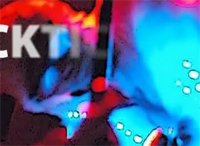
Keynote: Dr. Joseph Weizenbaum
Digital Art Weeks 2007 at ETH Zurich :: July 10 - 14 :: Keynote: Dr. Joseph Weizenbaum :: ETH Zurich, Auditorium Maximum, F 30 :: Host: Prof. Dr. Jürg Gutknecht, Computer Science Department (D-INFK) :: Additional keynote speakers at this year's Digital Art Weeks: Régine Debatty (we-make-money-not-art), Jeffrey Huang (EPF Lausanne), Helen Thorington and Michelle Riel (turbulence.org), Roger Malina (CNRS Marseille).
The DIGITAL ART WEEKS program is concerned with the application of digital technology in the arts. Consisting of symposium, workshops and performances, the Digital Art Weeks program offers insight into current research and innovations in art and technology as well as illustrating resulting synergies in a series of performances during the Digital Art Weeks Festival each year, making artists aware of impulses in technology and scientists aware of the possibilities of application of technology in the arts.
We are proud to announce this year's special guest Prof. Dr. Joseph Weizenbaum, author of the influental book "Computer Power and Human Reason - From Judgment to Calculation" (1976). He will open the festivities with a talk directed at both scientists as well as cultural workers. His talk will be followed by two important documentary films on computer science. The first concerns Weizenbaum's life and work and the second shows how influential computers can be on the arts.
Keynote Address
Prof. Dr. Joseph Weizenbaum
In 1972 I published a paper under the title: On the Impact of the Computer on Society (Science, Vol. 176, Issue 4035, pp. 609 - 614, May 1972). Four years later the Book: Computer Power and Human Reason - From Judgment to Calculation (Freeman, San Francisco 1976). Years later, I began to have second thoughts about the titles of both works. Yes, the computer had enormous impact on societies world wide. But it became ever clearer to me that the very shaping of computers, the very manner of their development and refinement, the actual purposes, ex and implicit, for which they were created, that all of these were determined by the values of the societies in which they were imbedded, My paper should have been On the Impact of Society on the Computer and not the other way around. The main thesis of the paper should have been that science and the technology are not value free, that both inherit their values from the society in which they are imbedded. Insane societies produce insane ideas and corresponding instruments. Warier societies produce weapons, and, in our time, weapons of mass destruction.
As for the Book: Its subtitle, it is now clear to me, should have been its main title. For now, obviously, judgment in human affairs has been and is increasingly replaced by calculation. The largely self appointed deep thinkers of our time preach that all aspects of reality are computable. Things are "figured out". Parameters are optimized, strategies computed. Human beings are said to be "merely" machines whose fates are anyway determined by the natural laws that the physicists teach the neurologists, they the behavioral scientists and they, in turn, those who say they are philosophers. And all of them compute. They cannot do otherwise, for concepts such as wisdom, dignity, will, respect, kindness love and joy and grief simply do not exist in their universes of discourse. They are not measurable, not computable, not part of their vocabulary and hence not of their reality. What remains for them IS indeed calculable. The fundamental dogma of our time is that to understand a thing is to be able to program it ... finally to simulate it in the form of a computer model. Then, truly, the intelligent robot becomes the ideal of what it means to be human.
If the above is true, then, a question becomes of enormous relevance to our time: what should be the highest priority of formal education, independent of whether in the schools or in so-called higher education? It is a matter of utmost importance, for whenever something new is to be inserted into a curriculum, something already there has to be reduced or eliminated. It is a question of what, in education, is more important than what else. For example, how much more important, if at all, is it to teach the writing of computer programs as opposed to teaching the history of one's homeland?
The answer to the central question is, it seems to me, obvious and true for all places and all times: the first priority of formal education is to educate students to master their own language, to give them the ability to clearly articulate their thoughts in speech as well as in writing ... and that also implies to be able to listen and to read, to critically interpret the vast flood of signals that constantly impinge on all of us. I want to emphasize the distinction between hearings and listening, namely that hearing is largely passive while listening involves thinking and judgment. Absent this ability, as I believe it to be in very large parts of our people, condemns the afflicted to a life of servitude to the clichés, half-truths and lies served up by the overwhelming majority of the world's mass media!
Posted by jo at 03:13 PM | Comments (0)
Josephine Bosma, Mediated Remains:
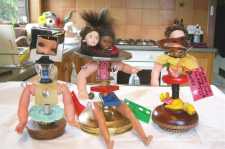
Hidden Bits of Ourselves
[This essay was written by Josephine Bosma for the graduation show catalogue of the Media Design M.A. programme of the Piet Zwart Institute, Willem de Kooning Academy Rotterdam. The show will open on Saturday, July 7th, 15:00 + 21:00, at WORM, Achterhaven 148, 3024 RC Rotterdam]
The Human System: Technology is part of the body. Humans have been able to sustain themselves in the world by incorporating bits and pieces of that same world into their own expanding physical system (the monkey and his stick are one). A celebration of technology is a celebration of ourselves. A critique of technology is a critique of ourselves. An investigation of technological systems and errors is an investigation of the way we recreate and handle ourselves. The 'body' can be perceived as a collection of systems and fragments of systems. It is at the same time dispersed and whole. We are experiencing a continuous but fruitful fragmentation and recombination.
The 2007 graduation show of the media design students of the Piet Zwart Institute seems to revolve around one theme, even if it was not consciously chosen. All works show a fascination for obscurity, for the hidden, for the disappearing, for the superfluous. The graduates explore drifting fragments of ourselves in our media environment. These fragments are sometimes part of hidden processes and at other times they are (remnants of) unwanted objects: trashed bits. A few of the projects are not based on the obviously hidden.
These projects reveal the delicate obscurity inherent to old and new taboos: from the acceptance of physical death to the 'death' of the author. All works deconstruct or question the wholeness of the image. Our expectations of technology, and our exchanges with it, reflect not only simple needs and desires, but they also reflect value systems. It should be quite safe to say that one of the most dominant drives behind technological developments is a quest for perfection. Perfection is always a highly subjective experience, yet throughout history it has mostly been connected to the divine, to the whole, to the absolute. Like we have projected perfection outside of our messy, mortal bodies onto a divine power, we have projected a similar higher power onto our willful material attempts to a state of perfection through technology. The promise of perfection has even become one of the most persistent slogans in present day advertising. We can have the perfect hair, the perfect smile, the perfect car, the perfect phone and the perfect software solution for your company. Our relationship with technology has almost become a matter of faith.
In Praise of Noise
In the beginning of the 20th century the Futurists exclaimed a loud, naïve yet energetic praise of technology. This art movement seemed to believe in the technological triumph of man over nature. Filippo Marinetti writes an ecstatic piece about the car in his famous Futurist Manifesto: "We are already living in the absolute, since we have already created eternal, omnipresent speed". The Futurists glorified technology through practically all art disciplines: from architecture and theatre to painting and music. Marinetti's Futurist colleague Russolo invented a new kind of musical instrument, an instrument to create noise, the 'intonarumori', which was to be more in tune with modern life then violins or pianos could ever be. It even had to create an appreciation of the sounds of war. Was it their glorification of war and violence, which made John Cage write his 4'3'', 4 minutes and 33 seconds of silence, in 1952? It does not matter, for both Russolo's manifesto The Art of Noises and Cage's 4'33'' opened the musical ear to the previously non-musical, to machinic noise and environmental sound as music.
Noise is always transgressive and as such it is part of the obscure. Even in contemporary music, in which it is largely accepted and perceived as an inextricable part of a track or song, loud or dissonant sounds are still recognizable as noise. Noise cannot be safe. Noise is accepted as music, but it is still an outsider, a polluter, a sign of dissidence and discordance. Much like the ultimate state of perfection, the divine, the ultimate noise equals the experience of near death. The ultimate in noise is that of white static: the death of the televised image. Whereas the Futurists created music that more or less celebrates technological productivity, Piet Zwart graduate Nancy Mauro-Flude seems to pay homage to its neglected, inescapable imperfection. She has built her own noise instruments from trash, to be used in her performance art. Performance art is noise by many standards (as art is often perceived as superfluous in itself and performance is the most fleeting form of it), yet in the environment of media art it tends to represent the source of all technological imperfection: the body. Nancy Mauro-Flude's "breakcorenoise- performance" 'Paraphernalia' is a temporary (re-) combination of dance and noisy, trashy and poetic fragments.
The transgressive and dissonant qualities of noise make it attractive for so-called alternative music cultures. Noise in that case represents criticism and rejection of commercial and mainstream music cultures. Andreea Carnu's project 'Incoreporated' is a pr company for the punk and hardcore music community. She combines contemporary research (in this case statistics retrieved from myspace) with personal consultations with musicians in order to make 'hardcore' tailored business plans for punk bands, for whom a dedication to noise apparently can make them loose touch with reality altogether. Carnu seems to want to create not just a commercial enterprise, but also a monument and ode to the hardcore punk, counter-cultural lifestyle.
Noise represents the fallable physical source of technologies. It reminds us of our most basic self, of our imperfect body, of illness and death. The imperfect, mortal body is but a faint echo in our mediated environment. We have become nearly numb to images and news of death and disaster in far away countries. Yet as mediation starts invading every aspect of our own lives we loose a sense of intimacy with our loved ones too. This is what Audrey Samson's 'Spectres?' is about. She recorded several personal stories about death for us. We have to listen to them standing at a crowded bar, with headphones on. This experience is moving and embarrassing at the same time. Death is carefully edited out of our lives. The dead and stories of death have turned into electronic ghosts that we can turn off and switch on again, like in for example John Jesurun's 1986 award winning play about a boy that gets trapped in a cinematic projection: Deep Sleep. In western culture only two things equal death in their transgressive qualities: sex and violence. Strangely enough depictions of sex are often censored more strictly then those of violence. The orgasm is sometimes called 'the small death'. Sex and orgasm in particular are a threat to the quest for the perfect, whole body. In the digital domain several tools have been released that are supposed to automatically cleanse our sexual experience. Dominik Bartkowski's project with the provocative title 'Bareback' takes these tools and turns their purpose around. Instead of filtering the most sensitive, 'bare' sexual imagery, the filter becomes an aesthetic tool, creating special visual effects. Instead of accepting the morality of the filter, it reveals the dubious logic behind it. Bartkowski is critical of the trend towards automated filtering. The definition of noise is often too subjective and temporal to be left to a machine.
Defragging Culture
There are also other trails through the static. The digital terrain is layered, logical, but 'flexible'. We create distinctions and rules in this environment that are by no means demanded by its structure. We tend to disregard the importance of what we choose to leave out (and what we can only hide from sight). As we develop our physical selves in this further mediated environment (as in Katherine Hayles' posthuman) we accumulate a huge amount of technological and cultural debris in our trail, which is just as telling about us as our 'official', neatly raked path is. In the digital age the amount of hastily discarded trash and obscured technological traces has grown exponentially.
This explosion of technical, cultural and social traces might be a nightmare for authorities, but they offer a radically fertile ground for all kinds of explorations. The fecundity of our current media environment is almost poisonous in its strength. It is because of this that we witness an explosion of all kinds of play with existing digital structures (like SecondLife, Google or social software such as MySpace). Artists and designers are tapping into the boiling sources of our information flows and they find a huge amount of superfluous, hidden, 'cached', filtered, forgotten or trashed material to toy with. This is the new wealth: a simultaneous, indistinguishable production of culture and cultural sources.
In 1998 the american artist Perry Hoberman presented an installation called 'Systems Maintenance' at the Rotterdam based institution for unstable media V2. In this installation the audience was invited to allign a set of furniture in physical space with its copy in digital space, the result of which could be followed realtime via a projection on the wall. This deceivingly simple work revealed its magic when interacting with it. It turned out to be very, very difficult to allign the apparently identical objects in the two different worlds. Frustration and despair grew by the second. 'Systems Maintenance' was a brilliant combination of poetic and conceptual gestures. I was reminded of it when seeing Walter Langelaar's project 'TODO (Tangled_Object_Description_Overview)'. Langelaar uses 3D object material from Second Life which is 'mixed' with a representation of the WORM building (in which the Media Design graduation show takes place) taken from Google Earth. The new virtual structure that is created this way is then 'collided' with the original building. Differences are emphasized by adding them to the original building physically, by "perforating" the real space with virtual architecture. Whereas Hoberman lets the audience actively experience the awkward split between physicality and activity in real and virtual environments, Langelaar chooses a more subtle approach. Much like Jan Robert Leegte, just like Langelaar originally a sculptor, he creates a sense of estrangement by literally placing virtual objects outside of the digital grids into the real world. If Hoberman is skeptical of our new environments, Leegte and Langelaar experience it much more as a room for play and surprise.
The mathematical structure of the internet, despite the human landscape created in it, simply begs for systematic and generative art practices to explore it. Like traditional sculptors will see a lump of clay or wood and feel the possible structures inside of it, artists working with the net see connections and metastructures most of us are blind to. Already 8 years ago the first net art generators started to appear. The most (in)famous one is the one created by german artist Cornelia Sollfrank, whose 'net.art generator' was part of a larger project called 'Female Extensions'. Sollfrank is still exploring the legal consequences of her 'net.art generator' today, since she stumbled upon possible lawsuits when creating exhibitions of it. Piet Zwart graduate Marc de Bruijn has now built a web site generator, a work entitled 'This website is under construction'. De Bruijn is very critical of web design and created his generator as an ironic statement on hypes and fashions, such as the 'web 2.0' buzz. His software includes the option to create four different aesthetics: the aesthetic of the amateur, the aesthetic of web 2.0, the corporate design aesthetic and that of graphic design. By turning these design clichés into caricatures he forces an escape from failing web design, and 'teases out' a new approach.
Sometimes caricatures can be hard to recognize. The most subtle form of satire is the one in which the subject in question does not really notice he or she is being ridiculed, or responding to the joke would be more damaging then the joke itself. One such work is a relatively unknown work from 1997 by the artist Vuk Cosic: 'Mira'. 'Mira' shows a picture of the wife of Slobodan Milosovic, the late president of Serbia. Cosic calls Mira Milosovic "the cannibal" in one of his texts on the mailing list nettime. The audience can choose different flowers to put into Mira's hair. Mira Milosovic was known to wear flower corsages, a habit that rather contradicted her bad reputation. Shahee Ilyas has created a similar ironic tool, which generates frames for portraits of presidents and other rulers of countries. 'Framing Leaders' uses statistics of various sites to track the freedom of press in a country and the length of reign of its leader. The data then are used to generate more or less ornamental frames around the picture of a particular leader. The heavier and more pompous the frame is, the less democratic is the depicted leader.
Reading into data, interpreting information, has become the new challenge, and not just for marketeers and authorities. Most of this reading and interpreting, like Ilyas' work, is done automatically. It is virtually impossible nowadays to surf around the web without enabling your browser to accept cookies for instance. Cookies gather information about Internet users. They are relatively invisible, only showing themselves in almost hidden directories on your harddrive. Andrea Fiore developed a plug in for the Firefox browser that allows the user to do a bit of countersurveillance: cookies are tracked and the information about them gathered in an online database. The 'info-cloud' that is constructed this way maps the use and spread of cookies, enabling a view of the extent of for instance ad campaigns. A different view of the Internet then unfolds.
Delicious Pre-Decompositions
We are witnessing a new form of recombination of materials that bears resemblance to earlier forms like collage, quotation, citation, assemblage, but which is more evident, more inescapable, due to changed technological parameters. Writer and DJ Kodwo Eshun described this situation in relation to music and sampling in an interview published in his book 'More Brilliant Than The Sun', already in 1998: "The idea of quotation and citation, the idea of ironic distance, that doesn't work, that's far too literary. That assumes a distance which by definition volume overcomes." The sheer volume of technological bits, scraps and products that surrounds us and the simple means to re-interpret, re-arrange and re-use them almost within the blink of an eye is turning cultural production into a form of cultural scavenging.
The fragmentation of culture, due to new technologies and also due to sheer volume of information, is seldom represented through 'old' media such as books. Experiments are scarce and often unsuccessful. New publishing techniques, especially publishing on demand, slightly erode the illusion of completeness of the book. Publishing on demand often refers to single or few prints of a specific book. Like unprinted publications however, the book now becomes personalized, and is created from unique, individual choices by the reader.
In 2003 the Museum of Contemporary Art in Oslo hosted an exhibition about net.art called 'Written in Stone'. This exhibition had a unique catalogue, which visitors could assemble on the spot by choosing texts on a computer, printing them and having them bound. The catalogues even had an ISBN number. This years graduation show of the Piet Zwart has a similar catalogue. It is the graduation project of one of its students: Jorrit Sybesma. 'Design Paradigm Shifts' allows for the audience to choose an individualized catalogue. There are two options: a simple, basic, informative catalogue or an elaborate, individually adjusted catalogue. The latter contains unique, specially generated pages of the work of each artist. The pages are not bound into a traditional book, but presented as loose leaves in an envelope that accentuates each individual gift. What better way then to present this exhibition of fragments, scraps, traces, bits and noises?
Josephine Bosma, Amsterdam, June 2007 [via nettime]
Posted by jo at 02:32 PM | Comments (0)
Upgrade! Tel Aviv-Jerusalem

Dan Phiffer + Mushon Zer Aviv
Upgrade! Tel Aviv-Jerusalem: Dan Phiffer (US) & Mushon Zer Aviv (IL) - ShiftSpace (the talk will be held mainly in English) :: July 10, 7:30 pm :: Minshar Art School, David Chachmi st. 18, Tel Aviv :: Free Entrance.
While the Internet's design is widely understood to be open and distributed, control over how users interact online has given us largely centralized and closed systems. The web is undergoing a transformation whose promise is user empowerment--but who controls the terms of this new read/write web? The web has followed the physical movement of the city's social center from the (public) town square to the (private) mall. ShiftSpace attempts to subvert this trend by providing a new public space on the web.
By pressing the [Shift] + [Space] keys, a ShiftSpace user can invoke a new meta layer above any web page to browse and create additional interpretations, contextualizations and interventions - which we call Shifts. Users can choose between several authoring tools we're working to develop - which we call Spaces. Some are utilitarian (like Notes and Highlights) and some are more experimental / interventionist (like ImageSwap and SourceShift). In the near future users will be invited to map these shifts into Trails. These trails can be used for collaborative research, for curating netart exhibitions or as a platform to facilitate a context-based public debate.
Recent commissions from Turbulence.org and Rhizome.org will help ShiftSpace continue to grow its user base and further its Open Source model. It will support our upcoming goals including a developer API, a workshop series, a ShiftSpace commissions program and a research into peer-to-peer network architectures.
Dan Phiffer is a new media hacker from California, interested in exploring the cultural dimension of inexpensive communications networks such as voice telephony and the Internet.
Mushon Zer-Aviv is a designer and a media activist from Tel-Aviv, interested in challenging the perception of territory and borders and the way they are shaped through politics, culture, globalization and the world wide web.
Posted by jo at 02:11 PM | Comments (0)
transmediale.08 – Conspire ... | club transmediale.08 - Unpredictable
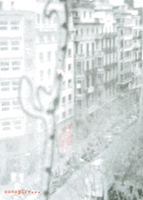
Call for Entries
transmediale.08 – Conspire ... festival for art and digital culture berlin :: 29 January - 3 February 2008 AND club transmediale.08 - Unpredictable :: festival for adventurous music and related visual arts :: 25 January - 2 February 2008 :: Call for Entries - Deadline: 7 September 2007 :: Award Ceremony: 2 February 2008.
Together, transmediale and club transmediale invite the submission of works and projects for the festival 2008. Submissions for both festivals participate in the transmediale Award 2008, for which an international jury will award prizes totalling ca. 10 000 EUR. Abstracts and papers for a proposed Vilém Flusser Theory Award are also being invited.
As one of the leading international festivals for art and digital culture, transmediale presents and pursues the advancement of artistic positions reflecting on the socio-cultural, political and economic impact of new technologies. It seeks out artistic practices that not only respond to scientific or technical developments, but that try to shape the way in which we think about and experience the technologies which impact virtually all aspects of our daily lives. As such, transmediale understands media technologies as cultural techniques that need to be embraced in order to comprehend, critique, and shape global societies.
club transmediale (CTM) is a prominent international festival dedicated to contemporary electronic, digital and experimental music, as well as the diverse range of artistic activities in the context of sound and club culture. CTM presents projects that experiment with new aesthetic parameters and new forms of cooperation, develop possibilities for informational and economic self-determination, and reflect on the role of contemporary music against the backdrop of technological and social transformations. Now more than ever, music emerges as a laboratory for multiform experiments and as an active agent that allows for new cultural techniques to be tested and proffered to the wider world. CTM puts the focus on direct experience, risk-taking and personal interaction, and thereby emphasises the situational potential of live performance, the interplay of various media – sound and image, in particular – and candid exchange between sub-cultural and academic initiatives.
transmediale is a project of the Kulturprojekte Berlin in cooperation with Haus der Kulturen der Welt. transmediale is funded by the German Federal Cultural Foundation. club transmediale is funded by Hauptstadtkulturfonds.
Posted by jo at 01:58 PM | Comments (0)
Found Footage Workshop
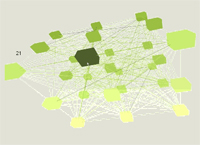
Call for Select Participants
Open Call: Found Footage Workshop :: Deadline: August 1, 2007 :: Announcement of selected participants: August 10, 2007 :: Organizer / Location: KSAK-Center for Contemporary Art, Chisinau Workshop Period: 9-25 September 2007 (six hours per day, six days per week). Participants: 15 persons will be selected from Moldova, Romania, Bulgaria, Macedonia, Bosnia & Herzegovina, Kosovo, Serbia & Montenegro, Croatia, Slovenia.
The Found Footage Workshop is an in-depth exploration of the use of archival material, the aesthetics of appropriation, sampling and detournement, and the transfer of cinematic language to digital forms. The workshop will consist in theoretical presentations, film screenings, and assisted hands-on workshops (selection of archival sources, analogue-digital transfers, montage). Each participant will produce a film based on the re-use of archival sources. The workshop will provide an opportunity for cross-cultural exchange between artists and students from Moldova, regional artists from Balkan countries, and the international guests who have been invited to prepare the workshop.
Guest tutors & content of the workshop:
John Davis (San Francisco, USA) is a media artist exploring the intersections of film, video, photography, experimental sound and social practices - Introduction to the reuse of popular culture for critique, satire and poetic investigation. Assisting participants in extracting fragments from sources like film, VHS, DVD, television and the internet, and incorporating them into projects that reshape the media landscape with their personal vision. Screening of American found footage films.
Joanne Richardson (Cluj, Romania) is a cultural theorist, video artist and coordinator of D Media, an NGO producing digital media & engaged art. - Introduction to history of found footage and detournement, its relation to struggles against intellectual property, and the political dimensions of "counter-documentary." Assisting participants with developing concept / montage. Screening of 1960-70s French films and post-1989 found footage from Eastern Europe.
Stevan Vukovic (Belgrade, Serbia) is an art critic, film theorist, curator, and co-founder of Belgrade Art Initiatives. Links: http://www.baza.org.yu, http://www.o3.co.yu, http://www.schoolofmissingstudies.net - Introduction to recent documentary film and video production from the Balkans. Screening of films by Zelimir Zilnik and other Serbian directors.
Kathrin Becker (Berlin, Germany) is an art historian, curator and the director of NBK (Neuer Berliner Kunstverein) Video Forum. - Introduction to the NBK Video-Forum Archive. Screening of international artist videos from late 1960s to the present from the NBK collection.
Film Content/Production: The workshop aims to facilitate a critical engagement by artists toward the current condition of post-soviet (former USSR) or post-socialist societies. We are especially interested in investigations that use film aesthetics and digital technologies to explore and comment upon the "transition" (gaps, ruptures, or continuities) between the dismantling of socialism and the current neo-liberal system, although artists can also propose ideas that depart from this focus. Each participant will develop a film scenario, select and choose appropriate archive sources corresponding to the idea, and edit a short digital film (5 to 10 minutes in length). The basic principle underlying the concept and production of the film should be the re-use or re-contextualization of archival sources, including propaganda films and archives from the socialist period (KSA:K has an available collection of these), fragments of new films, home movies or private archives, television and internet.
Skills gained by taking the workshop: Selecting and digitizing analogue materials (16 - 8 MM film, VHS), filming with professional cameras, editing with AVID, postproduction techniques. Films will be finished on mini DV and exported to DVD. Please note that some prior experience in video production (camerawork, montage) is required.
Practical information: Selected participants will receive reimbursement for travel costs (train or bus), their accommodations and meals will be covered by the organizer for the duration of the workshop. There is no participation fees.
Criteria and submissions: Applicants should be nationals or residents of Moldova, Romania, Bulgaria, Macedonia, Bosnia & Herzegovina, Kosovo, Serbia, Montenegro, Croatia, or Slovenia. We are looking for inspired proposals by visual artists, filmmakers and video activists that envision an intersection (dialogue, clash or complementarity) between past histories and present realities. Interested artists will prepare a proposal package containing the following documents: a CV (1-3 pages), a short statement about the particular interest in this workshop (150 words), a film synopsis (500-600 words), a production plan or timeline, and a tentative list/description of archival sources to be used. If these archival sources are difficult to find and specific to the region, artists are encouraged to bring them along. The application documents should be sent as a single file (.doc, .rtf or .pdf) by email. If applicants would like to submit samples of previous works, the package can be sent by post to the following address, but the electronic documents should also be sent separately by email to:
Stefan Rusu - FFW project curator
E-mail : suhebator[at]gmail.com,
ksak.info[at]mail.md
Addresa: Centrul pentru Arta Contemporana , Chis8ina u -[KSA:K], Str. Independent8ei, 1, (Colegiul Al. Pla ma deala ) Cod pos8tal: MD-2043, Chis8ina u, Republica Moldova Web site: www.art.md
Phone: GSM+37369312435
Tel. +37322 772507,
tel/fax: +37322 573395
Project partners: D Media Association, Romania, Baza - Belgrade Art Initiatives, Serbia, and NBK Video Forum, Germany.
Center for Contemporary Art-[KSA:K] is a non-profit, independent institution registered in the year 2000. The new strategy of the Center is the development of cultural forms and art practices, which would reflect the dynamic of the social, political and economic transformations of the society. Center pleads for the advocacy activities in promoting of the cultural policies suitable for the defining and the consolidation of the artist position and contemporary art practices in the society.
This project is supported by ECF (European Cultural Foundation), Amsterdam; USA Embassy in Rep. of Moldova; Fine Arts College Al. Plamadeala; The Union of Cineastes from Rep. Moldova.
Posted by jo at 12:36 PM | Comments (0)
Flash Cube

Photographic Perspective
Flash Cube :: July 5 - September 30, 2007 :: Leeum, Samsung Museum of Art 747-18, Hanam-dong, Yongsan-gu, Seoul, Korea 140-893 :: Opening: July 4, 6.00 p.m. :: Panel discussion: Mapping Photographic Space: Thomas Demand, Jan Kaila, Sanggil Kim, Aglaia Konrad, Henk Slager :: July 5, 1.00-5.00 p.m.
Since its acceptance as a form of art around the 1930s, photography has been forced as no other artistic medium to justify its medium-specific qualities. Particularly, the Greenbergian heydays of Modernism have produced such pressing urge for justification. At that moment around the end of the 1930s, painting had surpassed by far its interest in the subject of perspectivist illusion. As a consequence, painting entirely concentrated on the qualities of the two-dimensional surface implying a passion for painterly components such as planes, colors, and lines. From that time onwards, the artistic working field of perspectivist painting would be remediated by photography as an artistic medium.
However, in the artistic practice of our day, which, in line with New York-based theorist Rosalind Krauss could be said to be determined by a post-medium condition, the photographic image can no longer be viewed as a mere aesthetic registration of a situation in the real world. Rather, the topical photographic image demands the investigation of how the photograph as an imaginary medium produces diverse forms of realities and worlds which are still based on its perspectivist capacities.
Such researching attitude requires a critical reevaluation - either through other media or through the history of the photographic medium - of the photographic medium as such. Subsequently, the medium-specific qualities of the photographic image have been deconstructed effecting a turn to captivating forms of spatial investigations.
Indeed one could argue that a critical attitude towards framing, centristic, and perspectivist styles of photography produced a novel generation of photographers fascinated by spatial environments and architectonic constellations. That fascination is connected with interesting, topical forms of photographic criticism on functionalist ways of thought parallel to perspectivist-based photography and on the subdivision of a 3D world into transparent, comprehensible, and instrumental entities.
The exhibition Flash Cube will chart a series of such spatial research strategies implicating a diversity of artistic points of departure such as fluid inner space, open urban space and installative space. The various photographic strategies will be mutually confronted in a transformative way in the exhibition's methodology of mounting (floorplan) - underscored by Rem Koolhaas’ unique non-perspectivist display system of Leeum's exhibition space - so that both spatial reflection and spatial experience can occur in dynamic and invigorating ways.
Artists: Gerard Byrne, David Claerbout, Thomas Demand, Jonas Dahlberg, Geert Goiris, Andreas Gursky, Noritoshi Hirakawa, Klaas Hoek, Candida Hofer, Jan Kaila, Sanggil Kim, Koo Jeong A, Aglaia Konrad, Yoon-jean Lee, Armin Linke, Hermann Pitz, Thomas Ruff, Hiroshi Sugimoto, Haegue Yang, JeongMee Yoon, Mieke Van de Voort and Jeff Wall :: Curator: Henk Slager :: Coordinator: Hyesoo Woo.
Flash Cube was also made possible by Samsung Electronics, Cyworld, Asiana Airlines and the Mondriaan Foundation.
Posted by jo at 09:42 AM | Comments (0)
July 03, 2007
Luke's Binoculars
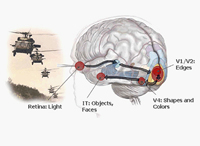
Pentagon to Merge Next-Gen Binoculars With Soldiers' Brains
"U.S. Special Forces may soon have a strange and powerful new weapon in their arsenal: a pair of high-tech binoculars 10 times more powerful than anything available today, augmented by an alerting system that literally taps the wearer's prefrontal cortex to warn of furtive threats detected by the soldier's subconscious.
In a new effort dubbed "Luke's Binoculars" -- after the high-tech binoculars Luke Skywalker uses in Star Wars -- the Defense Advanced Research Projects Agency is setting out to create its own version of this science-fiction hardware. And while the Pentagon's R&D arm often focuses on technologies 20 years out, this new effort is dramatically different -- Darpa says it expects to have prototypes in the hands of soldiers in three years...
The most far-reaching component of the binocs has nothing to do with the optics: it's Darpa's aspirations to integrate EEG electrodes that monitor the wearer's neural signals, cueing soldiers to recognize targets faster than the unaided brain could on its own. The idea is that EEG can spot "neural signatures" for target detection before the conscious mind becomes aware of a potential threat or target." From Pentagon to Merge Next-Gen Binoculars With Soldiers' Brains by Sharon Weinberger, Wired.
Posted by jo at 02:31 PM | Comments (0)
Digital Borders
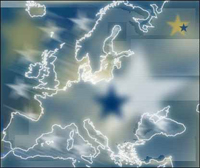
National boundaries have survived in the virtual world
"... [W]hat we once called a global network is becoming a collection of nation-state networks—networks linked by the Internet protocol, but for many purposes separate.
The bordered Internet is widely viewed to be a dreadful development that undermines the great network's promise. But the Net's promise was not fulfilled by the 1990s vision of an Internet dominated by the English language and the idiosyncratic values of the American First Amendment. People who use the Internet in different places read and speak different languages, and they have different interests and values that content providers want to satisfy. An Internet that accommodates these differences is a more effective and useful communication tool than one that does not. [...]
To understand the virtues of a bordered Internet, consider the opposite: an Internet dominated by a single global law. When you choose a single rule for six billion people, odds are that several billion, or more, will be unhappy with it. Is the American approach to Nazi speech right, or is the French variant? To what degree should gambling and pornography be allowed? Should data privacy be unregulated, modestly regulated, or heavily regulated? A single answer to these and thousands of other questions would leave the world divided and discontented..." From Digital Borders - National boundaries have survived in the virtual world—and allowed national laws to exert control over the Internet, by Jack Goldsmith and Timothy Wu, Legal Affairs.
Posted by jo at 01:51 PM | Comments (0)
[iDC] From a Crisis of Value to a Crisis of Accumulation
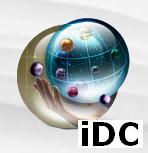
Questions of Value and Ethics
[...] Excerpt: The Impending Crisis of Value [by Adam Arvidsson] - It is becoming ever more obvious, as even the mainstream business press is acknowledging this, that the information economy is split in two; we have two economies rather than one (or three, if we include the growing criminal or informal economy which we will not treat in this paper). On the one hand, there is the traditional capitalist economy that works with monetary incentives. This economy still handles the main part of material production: the production of cars, shoes, computer chips, and the transportation and maintenance of these goods. But immaterial production- the production of the ideas, innovations, experiences and other intangibles that virtually everybody agrees to be the most important source of value and development- is increasingly performed by another economy that does not primarily move according to monetary incentives. Most people who participate in creating the enormous wealth of content that give MySpace or YouTube their market values are not in it for the money. Instead they want to build networks, make friends, show off, be cool or what have you. The same thing goes for the users who participate in the multitude of smaller, less famous sites that make up the new productive developments known as Web 2.0. ..." Read the essay here.
Michel Bauwens' response: http://www.p2pfoundation.net/Dornbirn_Manifesto
Also see Toward an Ethics of the Sociable Web. A Conversation Between Trebor Scholz and Mark Deuze.
iDC -- mailing list of the Institute for Distributed Creativity iDC[at]mailman.thing.net http://mailman.thing.net/cgi-bin/mailman/listinfo/idc
List Archive:
http://mailman.thing.net/pipermail/idc/
iDC Photo Stream:
http://www.flickr.com/photos/tags/idcnetwork/
Posted by jo at 10:53 AM | Comments (0)
FLOSS + Art = people.makeart
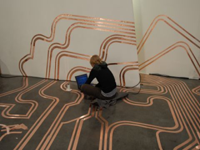
Call for Papers
FLOSS+Art :: Call for Papers :: Deadline: September 15, 2007 :: people.makeart is a new project by GOTO10. It is a repository of articles and lecture materials focused on the relationship between FLOSS (Free / Libre / Open Source Software) and digital arts, as well as a database of free digital art projects. The selected papers will be published on the people.makeart website and will be printed in the FLOSS+Art book, scheduled for spring 2008, using OpenMute's POD publishing service. GOTO10 is now accepting new, old and recycled papers on the following issues:
- opening digital art's practice, code and culture - FLOSS communities VS. art collectives - digital art licensing, copying and distributing, using open content models - role of the artist in FLOSS development - influence of FLOSS on digital art practices - free software to produce art and the art of producing free software - economy of an open digital artwork - FLOSS as an embedded political message in digital art - paradox and limitations of open licenses for digital art - FLOSS as a way to quote and embed other artworks in a new one - digital artist as a FLOSS developer / user and vice-versa - definitions and manifestos for a free software art - branching and forking of an open digital artwork - opening digital art to ensure future maintainance and porting.
Submission Procedures:
- Submit your final paper to pmafloss[at]goto10.org no later than September 15th, 2007. Include the text "FLOSS+Art" followed by your paper's title in your e-mail subject line.
- Submit as many papers as you want, one mail submission for each.
- Accepted formats : plaintext, LaTeX, OpenDocument. No other file format will be accepted.
- The paper must be attached to the mail, do not send us links
- The submitted paper must be written in English
- Paper must be 1500 words minimum
The FLOSS+Art POD publishing is a collaboration between GOTO10 and the Digital Research Unit of the University of Huddersfield and the Bergen Center for Electronics Arts with commissions and contributions from various organisations and institutions.
Posted by jo at 09:48 AM | Comments (0)
July 02, 2007
Re-Mediating Literature Conference
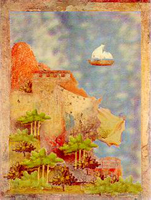
Relocating Literature within Networks, Technologies, + Media Studies
Re-Mediating Literature :: Utrecht University :: July 4-6, 2007 :: Recent developments in digital and electronic media have stimulated new theoretical reflections on the nature of media as such and on the way in which they evolve across time. The aim of this conference is to examine how recent technological changes have affected the 'old' medium of literature.
Multimedial and interactive texts, digitalized archives, cyberpoetics, and technological innovations such as foldable screens: together these have influenced the production and reception of literature, along with the ways in which we think about writing and reading. These ongoing developments call for a critical examination both of the relations between literature and the new media, and of the relations between literary studies and media studies.
The concept of 'remediation' in our title thus has a double thrust. Firstly, it refers to the transformative exchanges between literature and the new media: how has digitalization affected literature as a cultural medium? Secondly, 'remediation' indicates a relocation of literary studies within the broader field of (new) media studies: how could literary studies profit from the various analytical tools developed in (new) media studies and, conversely, how could our understanding of earlier phases in the evolution of the literary medium contribute to our understanding of present developments? By working on both these issues, we hope to relocate the place of literature within the milieu of modern media networks and technologies, but also to relocate the aims and practices of literary studies within the field of media studies.
Main themes:
A. New technologies and literary practices - the state of the field: will literature continue to develop as a schizophrenic medium, a hard medium of printed matter and an unstable medium of electronic data at the same time, or will it fork out in one of two directions? How is digitalization affecting reading practices and the circulation of literary texts? What new forms of intermedial and multimedial literatures are emerging?
B. Literature and the new media - the longer view: what new light do recent developments throw on the history of literature as a cultural medium and, conversely, how might insights from the history of the literary medium contribute to our understanding of recent developments? How can literary history be rewritten in conjunction with such media technologies?
C. Media compatabilities and competitions: new media hardly ever completely subject and annihilate older media. Rather, the two tend to co-exist, each taking on different tasks and responsibilities (cf. film and the novel in the earlier twentieth century). At the same time, however, they often interrupt and compete with each other (cf. television and the digital in the later twentieth century). How can this duplicity or compatability and competition be mapped and analyzed, and which are the insights that such analyses might yield into media formations as techno-cultural formations?
D. Disciplinary relocations: will literary studies become a branch of media studies in the foreseeable future - and if so, how? Will literary studies profit from such a relocation and how will this relocation affects its objects and methodologies?
Keynotes:
Marie-Laure Ryan: "Self-Reflexivity in Net-Art" - Self-reflexivity is widely considered by cognitive scientists a distinctive feature of the human mind. It is therefore not surprising that this fundamental thinking process should manifest itself in most human artistic and intellectual projects. The postmodern fascination with self-reflexivity can be attributed to the sense of pastness that permeates turn-of-the millennium culture. But self-reflexivity could also be a response to the curiosity aroused by the development of a new medium in search of its cultural function. By filling the World Wide Web with images and inverted images of its own utilities and by often making these utilities dysfunctional, Net.art invites us to reflect on the kind of immersion in digital culture that fools us into thinking that we fully control the technology that supports it.
Samuel Weber: "'Seagulls': A 'Script-Image' of Walter Benjamin" - No writer-critic of the 20th century was more attentive to intermedial questions than was Walter Benjamin. One of the forms this attention takes is his notion, and practice, of the "Schriftbild". This talk translates and reads this as a 'Script-Image' (Schriftbild). A Script-Image is both a written image, and one that "scripts" a scenario. This presentation will address one particular staging of a script-image: the short piece entitled "Seagulls" (Mvwen), one of five that Benjamin wrote in the summer of 1930 during a three-week trip to Scandinavia and then published under the title, "Nordic Sea" (Nordische See). (An English translation will be made available).
N. Katherine Hayles: "Narrative and Database: Remediating Literature Through Data" - Recently several theorists have proposed that database is replacing narrative as the dominant cultural form, among them Lev Manovich and Ed Folsom. This presentation will argue for that narrative is essential for human communication and culture, but it will also acknowledge that contemporary narratives are transforming through the impact of data. Remediation here implies that the feedback cycle described by Bolter and Grusin in Remediation can also be understood to take place through different cultural forms as well as through different media, where the dynamics are informed not by the hypermediation / transparency dialectic they describe but rather by the circulation through narrative and data.
Jan Baetens: "Novelization and Intermediality" - This paper tackles first of all the major characteristics of the novelization, a very popular although badly known example of intermediality in 20th Century storytelling (not "the film of the book", but "the book of the film"). Il will give a broad historical survey of the genre, which is actually as old as cinema itself, so to speak. In its second part, the paper tries to define what is really at stake when we study this genre, and why it can be interesting to focus closely on such a "minor", and often espised, practice. Finally, this paper presents a short analysis of one or two case studies, among them the novelization of Jacques Tati's "Les Vacances de Monsieur Hulot" by Jean-Claude Carrihre, a famous French screenwriter (his collaboration with Bunuel is still very famous) and author of various novelizations since his first attempt in the late fifties until today( cf. Goya's Ghosts, 2006).
Joanna Zylinska: "Logos bio-ethikos: What If Foucault Had Had a Blog?" -This paper focuses on one particular domain of contemporary media culture which blurs the boundary between the literary and the literal:blogging. Arguing that blogs aim at creating an experience of total life by building intricate systems of connections between online and offline spaces, personae and narratives, I will explore the extent to which practices facilitated by blogging can be interpreted in terms of bioethics. However, bioethics for me is not limited to the study of ethical issues arising from the biological and medical sciences. Rather it becomes a broadly conceptualised ethics of life, which requires judgement on what we understand by life in its different forms, and on what our position as those who deem themselves to be human is in this bioethics. Interestingly, Foucault associates the practice of self-writing precisely with an ethos of life. The keeping of individual notebooks focused on the recollection of the past is for him a matter of constituting a logos bioethikos for oneself, an ethics quite explicitly oriented by concern for the self toward objectives defined as: withdrawing into oneself, getting in touch with oneself, relying on oneself, benefiting from and enjoying oneself. This phrase logos bioethikos provides a key for my ereading of bioethics as a practice of good life, always on the way to becoming-a-good-life. But I suggest Foucault has in mind something much more material and direct than just a story about one s life and about how it should be lived: this practice of self-writing is actually said to produce a body. Drawing on Seneca, Foucault claims that writing transforms the thing seen or heard into tissue and blood. From this perspective diaries and blogs are not just commentaries on someone's life, already lived to this point but also somehow more real outside its narrative; rather they are materialisations of it, as I will argue in this paper. In doing so I will show that in blogging this materialisation occurs very much through an enactment of a different, more embodied, aware, and lively relationship with technology.
Posted by jo at 05:30 PM | Comments (0)
Treadmill jogging in Second Life
Moriash Moreau had the same thing going almost a year ago. [via 3pointD]
Posted by jo at 02:27 PM | Comments (0)
Spinal Rhythms:
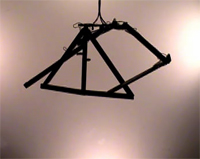
Autonomous Embodied Evolution of a Biomimetic Robot's Rhythmic Motion Behavior
ABSTRACT: "The robotic art work Spinal Rhythms investigates the qualities and dynamics of physical movement performed by inanimate shapes. To avoid mimesis the robot’s body is a primitive abstraction, a connected system of bare wooden limbs linked by joints. The spotlight lies on the action that brings this inorganic shapes to life - the motion. Actuated by elastic shape memory alloy springs the robot performs slow and noiseless movements that differ from robotics’ typical electrical motor characteristics. The movements are the subject of an embodied evolutionary computation process that controls the robotic performance. By repetitive mutation and evaluation the system evolves the actuation signals for the robotic muscles and makes the robot find temporal solutions for the sensitive dynamics between software, hardware and environment. The fault-prone hardware-body of the robot and changing environmental conditions create an unstable fitness landscape that demands continuous adaptation of the activation patterns. The evaluation process uses image analysis to grade the performance of motion patterns according to a fixed set of fitness functions and attempts to find activation patterns that produce more movement while consuming less energy. Trained in an autonomous loop without human supervision the robot is granted a certain awareness of its own body.
The art work presents a solution on how to bridge the gap between digital and robotic artificial life art. It introduces the shaping power of evolutionary systems – widely employed in digital artificial life – into a real-world setup full of complex dynamics and unpredictable conditions. The crucial differences between digital and analog worlds – constituted in the messiness and unpredictability of real life – are emphasized instead of being inhibited. The exhibition setup which shows one machine intelligence training another machine intelligence serves as an allegory on the future superiority of artificial intelligence that will advance without human help." From Spinal Rhythms: Autonomous Embodied Evolution of a Biomimetic Robot's Rhythmic Motion Behavior by EVA SCHINDLING. [PDF] Project website >>.
Posted by jo at 01:49 PM | Comments (0)
Dislocate 07 - Exhibition and Symposium - Tokyo
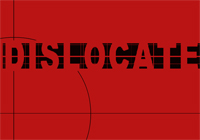
ART, TECHNOLOGY, LOCALITY
Dislocate 07: ART, TECHNOLOGY, LOCALITY - Exhibition, Symposium and Workshop series :: 24th July – 5th August :: Tokyo and Yokohama - Ginza Art Laboratory (Wednesday – Sunday 3-8pm); Koiwa Project Space (Tuesday – Sunday 2-7pm); ZAIM 28th & 29th July 11am-4pm - Symposium and Workshops; Opening Event Koiwa Project Space 24th July 7pm; Performance Event ZAIM 29th July 6pm :: All Events are Free.
The city is no longer built of concrete, a static posture no longer endures. Our surroundings have become a malleable space which can be warped, spliced and expanded at will. We no longer stand in one place alone, a mass convergence of coordinates is taking place beneath our feet. As we traverse these points of perpetual motion we are enclosed by structures of elsewhere, met with the sliding walls of other places which lead us through a never ending maze. Shrouded in alternative layers of space, we escape to another confinement through the mesh of new media.
As our presence is extended by the veins of technology our sense of space is transformed, our nervous system stems through endless reaches of universal skin. Our eyes see through a thousand windows, each with a different view, a collision of a multitude of global sounds meets our ears, our fingers pass beyond tiers of materiality.
But can we see what is before us? Are we listening to the resonance of our surroundings? Can we feel the texture of this place?
Engaged in distant or imaginary space, we flick through the channels with our remote control and choose when to plug in when to switch off. But as we are absorbed by these electronic pulses are we disappearing from the here and now?
Personal technologies offer a kaleidoscopic sensation of a multi-layered existence, but perhaps may also provide a microscope by which to examine the place which we are in at this moment.
Dislocate 07 – Festival for Art, Technology and Locality
Dislocate brings together a group of over 30 international artists in an exhibition, symposium and workshop series in Tokyo and Yokohama. Considering the spacial and social dislocation which can occur through technology, these artists are investigating how new media can be rooted in its specific location and form a meaningful relationship between ourselves and our surroundings.
Dislocate aims to explore the potential new media has to increase our awareness of our environment, enhance participation in our locality and community and transform our perceptions of the space we inhabit.
This project presents cutting edge approaches to new technology art but with a view to seeing beyond the technology itself, examining what lies past the screen.
Dislocate prompts us to reconsider the alternative uses of the personal technologies which surround us, not merely offering an escape route from our current situation but also a tool to actually confront this very location.
With an endless array of spaces available to us, we can select our contexts of participation like the channels of a television. We may be highly active in an online space, engrossed in our constructed personal space, but by choice or otherwise we may distance ourselves from our immediate surroundings. We are presented with the freedom of ‘unlimited’ possibilities and yet are we making these decisions consciously or are they occurring without thought?
Dislocate considers the very integration of new media with the environment and this might be utilized to consciously reconnect with our location, seeking to explore, question and debate how can technology be used to heighten our engagement with our surroundings instead of isolating us from our immediate space. When numerous places converge in one site, how do we navigate such space? How does our interaction within a given space formulate identity and how can this be communicated effectively to elsewhere?
These are some of the questions which will be raised through the Dislocate events.
Exhibition: Taking place over two sites, of contrasting locality, this exhibition aims to present a particular relationship to its surroundings, revealing new perspectives of our immediate space, engaging with and investigating this site while also fusing with spaces beyond. Works include a city wide game in which teams play against each other with their mobile phones, an exploration of the streets led by the beat of your heart, architecture which responds to environmental conditions and emotion mapping of the urban landscape.
Symposium: Christian Nold, Active Ingredient, Dan Belasco Rogers, Taeyoon Choi, So Hyeon Park, Erik Pauhrizi, Augmented Architectures, Sascha Pohflepp, Miguel Andrés-Clavera and Inyong Cho
Dislocate presents an international symposium with confirmed delegates from UK, Germany, Republic of Korea, Indonesia and Japan further contributing to the discourse surrounding the interplay of art, technology and location.
This symposium aims to explore what is meant by ‘locality’, how does new media impact upon our notion of space, our interaction with our surroundings, and how this can be used to transform communities, both virtual and physical. The conflicts and integrations which emerge as separate spaces collide in one site will be examined raising concerns of homogenization and de-contextualisation alongside the awareness of local identity and culture. This will include a scrutinization of sensitive, meaningful exchange between different localities facilitated through new media and the manifestations which reconnection or further connection with our environment can take.
Workshops: In a series of workshops participants will have the opportunity to engage further with some of the Dislocate artists and investigate with them in an active form of research and collaboration. The focus of these workshops will be upon the exploration of the surrounding environment, investigating its many layers and connections with other spaces. Workshops will enable direct participation and engagement with the locality and may also draw attention to our simultaneous interaction with elsewhere.
Workshop leaders include Christian Nold, who will present his bio-mapping project, allowing participants to create emotion maps of their travels through the city by the use of bio sensors. Erik Pauhrizi will lead a workshop exploring lo-tech solutions to advanced mobile and locative media.
Performance: Andreas Schlegel and Vladimir Todorovic; Naoko Takahashi; Musashino Art University Media Art Students.
All events are free
If you wish to attend the symposium or workshops please email info@dis-locate.net with your name and contact telephone number
Artists Include:
Active Ingredient www.i-am-ai.net
Christian Nold www.softhook.com
Dan Belasco Rogers www.planbperformance.net/dan/
D-Fuse http://www.dfuse.com/
Taeyoon Choi http://tyshow.org
So-Hyeon Park
Erik Pauhrizi http://butonkultur21.org/
Andreas Schlegel and Vladimir Todorovic http://syntfarm.org/projects/btc/
Yuko Mohri http://www.h6.dion.ne.jp/~moo/
Augemented Architecture http://www.augmented-architectures.com/
Stanza http://www.stanza.co.uk/sensity/index.html
Disinformation
For more information please contact Emma Ota: info[at]dis-locate.net
Participating Artists: Active Ingredient, Christian Nold, Dan Belasco Rogers, DFuse, Taeyoon Choi, So Hyeon Park, Erik Pauhrizi, Stanza, Yuko Mohri, Ryosuke Akiyoshi, Disinformation, Augmented Architectures, Martin Callanan, Frank Abbott, Sascha Pohflepp, Andreas Schlegel and Vladimir Todorovic, Mouna Andraos, Miguel Andrés-Clavera and Inyong Cho, Laurent Pernot, Esther Harris, Andreas Zingerle, Julian Konczak, Genevieve Staines, Marco Villani, So Young Yang, Liu Zhenchen, Nisha Duggal, Lori Amor & Kevan Davis, Maria Raponi, Lisa Mee, Leo Morrissey, Cary Peppermint & Christine Nadir, Anne-Marie Culhane, Jomi Kim, Harry Levene & Jon Pigrem, Naoko Takahashi, Son Woo Kyung.
Dislocate is supported by The Asia-Europe Foundation, The Sasakawa Foundation, The Daiwa Anglo-Japanese Foundation and Arts Council, England
Posted by jo at 12:08 PM | Comments (0)
Transitio_mx 02: Electronic Arts and Video Festival
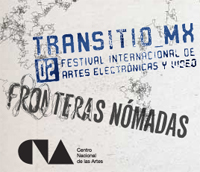
Call for Entries
The Electronic Arts and Video Festival, Transitio_mx is the most relevant platform in Mexico for the expression and analysis of the contemporary artistic practices with electronic media and the digital culture.
The title for the current edition of the festival is Nomadic Borders, making reference to the electronic / media arts through two metaphors: on the one hand, the border as the symbolic site that lies in the limit itself; on the other, the nomadic as an image of what is mobile, that which lacks a specific location. At the nomadic frontier there is no belonging, the communities developed there are always about to be built. From that idea, the conceptual axes of the festival are derived: Communities in Process and Processes in Community.
The main objective of the Festival is to support, recognize and spread production and current research around the artistic-electronic media, in an inclusive and expansive environment, by means of an exhibition, a symposium and a competition.
The competition is open to all individuals, groups and associations involved in the creative production using electronic media like videoart, sound art, net-art, installations, performing arts, performance actions and other related manifestations.
In the current edition, the National Council for Culture and the Arts, through the Multimedia Center of the National Center for the Arts, opens the calling for the following awards:
TRANSITIO AWARD: The national and international community is called to participate in the Second Electronic Arts and Video Competition that will be carried within the Festival framework from October 13th to 19th, 2007. During the Festival the following prizes will be granted as a recognition to produced work: A single prize worth $ 120,000.00 Mexican pesos or its equivalent in U.S. dollars. The honorary mentions that the Jury considers pertinent.
Proposals for this award will be taken in from the publication of this announcement and until July 27th, 2007 6:00 p.m. (GMT -6). No proposals will be taken in after this deadline. The shipping date can be taken into account as long as the shipment is done using express mail and not ordinary service. In case of international shipments, the package or envelope should be clearly labeled as "Cultural Material with no Commercial Value". The FESTIVAL WILL NOT COVER SHIPPING OR CUSTOMS TAXES COSTS.
SIZIGIA AWARD: The national and international community is called to send its electronic art proposals for the SIZIGIA project, coordinated by Laboratorio Curatorial 060. SIZIGIA is an island in the middle of the Usumacinta River, in the border between Mexico and Guatemala. After its claim as an independent territory by the members of Laboratorio 060, the island was mapped and transferred accurately to the virtual world of Second Life. By working as an independent zone in two planes of interaction, real and virtual, SIZIGIA is self-assumed as a micro-State possible of socio-imaginary confluences. The project impels the application of a biopolitical engineering through different interaction methods between real structures and virtual developments. As a part of their curatorial proposal for Transitio_mx 02, and to be presented in the international exhibition, Laboratorio 060 will coordinate the following awards:
Up to three virtual residences lasting 2 months for the development of the winning projects, which include the amount of 265.000 Linden dollars (approx $1000 USD).
Proposals for this award will be received from the publication of this call and until July 20th, 2007 6:00 p.m. (GMT -6). They can be sent through the Internet, or directly by courier to the Multimedia Center. No proposals will be taken in after the deadline. Proposals after the deadline will not be received. The shipping date can be taken into account as long as the shipment is done using express mail and not ordinary service. In case of international shipments, the package or envelope should be clearly labeled as "Cultural Material with no Commercial Value". The FESTIVAL WILL NOT COVER SHIPPING OR CUSTOMS TAXES COSTS.
TRANSNATIONAL COMMUNITIES AWARD: Granted by the US-Mexico Foundation for Culture, Inc, Fomento Educacional, A.C. and Fundación Cultural BBVA Bancomer :: The Transnational Communities Award is open to artistic, cultural and social projects that creatively use the technologic and conceptual tools available in the web, broadening the channels of communitarian communication and interaction and giving rise to spaces online where practices and stories are shared. The purpose of this award is to foster the access to cultural goods and to the technologies involved in its production and distribution, to promote the diversity of expressions and to recognise the citizen participation of the Transnational Communities that link Mexico and the United States in a daily and permanent way.
The call for submissions is open to individuals, groups, associations, organizations and institutions from Mexico and the United States that develop artistic, cultural and social projects for which the Internet is both a sufficient and necessary condition of viewing, expressing and participating.
Among the fields of activity subsumed are: video (communitarian video, documental, videoart, videoclip, videomail, telenovelas/soap operas), net.art, citizen journalism, digital communities, online forums, weblogs social networks, videogames online, online artistic collaboration projects, electronic literature, digital narrative, online communitarian radio, podcasts, etc.
During the Festival, the winner will be awarded with USD 3,500.
Proposals for this prize will be received from the publication of this call and until 6:00 p.m. (GMT -6) on July 27th, 2007. No proposals will be taken in after this deadline. The shipping date can be taken into account as long as the shipment is done using express mail and not ordinary service. In case of international shipments, the package or envelope should be clearly labeled as "Cultural Material with no Commercial Value". The FESTIVAL WILL NOT COVER SHIPPING OR CUSTOMS TAXES COSTS.
For further information on the submission please visit www.transitiomx.net/concurso
DOCUMENTATION: To obtain the information on the specific participation guidelines for each prize as well as the Application Form and all the information on the documentation that must be included, please go to the Festival’s webpage http://transitiomx.net or the Multimedia Center webpage http://cmm.cenart.gob.mx.
Or refer directly to:
Mariana Delgado
Communication and Public Affairs Coordinator
US-Mexico Foundation for Culture, Inc.
Tel. (52 55) 55 35 76 35
E-mail mariana[at]contactocultural.org
Posted by jo at 11:55 AM | Comments (0)
CONT3XT.NET / TAGallery
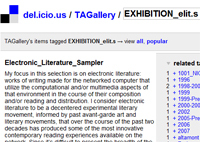
004_Electronic_ Literature_Sampler
TAGallery 004_Electronic_Literature_Sampler: [Scott Rettberg's] focus in this selection is on electronic literature: works of writing made for the networked computer that utilize the computational and/or multimedia aspects of that environment in the course of their composition and/or reading and distribution. He considers electronic literature to be a decentered experimental literary movement, informed by past avant-garde art and literary movements, that over the course of the past two decades has produced some of the most innovative contemporary reading experiences available on the network. Since it's difficult to present the breadth of the field in ten links, Ihe'll link to a few important collections of work and a few representative works among his personal favorites.
With projects/works by: The Electronic Literature Organization, N. Katherine Hayles, Talan Memmott (ed.), Ingrid Ankerson and Megan Sapnar (eds.), Ben Basan and Thom Swiss (eds.), Stephanie Strickland, Barbara Campbell, Robert Arellano, Rob Wittig, William Gillespie, Scott Rettberg, Dirk Stratton.
Tagger/Curator: Scott Rettberg is an electronic writer, and a founder of the Electronic Literature Organization. Rettberg is an associate professor of humanistic informatics at the university of Bergen.
TAGallery by CONT3XT.NET extends the idea of a tagged exhibition and transfers the main tasks of noncommercial exhibition spaces to the discourse of an electronic data-space. The method of tagging allows the attribution of artworks to different thematic fields. EXHIBITION_004 was tagged/curated by Scott Rettberg whose focus in this selection is on electronic literature: works of writing made for the networked computer that utilize the computational and/or multimedia aspects of that environment in the course of their composition and/or reading and distribution.
Exhibition
http://del.icio.us/TAGallery/EXHIBITION_elit.s
Tagger/Curator
http://del.icio.us/TAGallery/TAGGER_elit.s
Interview with Scott Rettberg
http://del.icio.us/TAGallery/TEXTS_elit.s
Posted by jo at 11:07 AM | Comments (0)
July 01, 2007
[iDC] SHOWING
![]()
Presentational rather than Representational
In our cultural landscape of blogs, webcams, profiles, live journals, and videosharing sites, the intimate lives of everyday people are on parade for all to see. One could say that a new culture of erotic exposure and display is on the ascendance, fueled by the impulse to reveal the self, and streamlined by DIY media technologies. In many ways this culture would seem to be less a representational than a presentational one, where we are compelled to solicit the attention of others, act for unseen eyes, and develop new forms of connective intensity -- as if this were somehow the very condition of our continued existence, the marker of our worth.
Within this new culture of self-exposure, one could say that the dream of panoptic power has vanished, or reversed course. Does the drive to willingly display the self constitute a surrender to the controlling gaze, or simply a shift in the dynamic of the game? For within these presentational environments, performance and role-playing reign supreme, and new forms of subjectivity and identity emerge.
These new cultures of self-display challenge us to rethink foundational concepts in film and media theory and, consequently, to rethink the very conditions of our approach. For clearly these cultures are not necessarily those of mastery and visual pleasure. They do not resolve easily to questions of perception, power, and language. They are cultures of showing as much as those of watching. Instead of a reliance on questions of spectatorship, representation, and scopic power, we are challenged to foreground issues of performance, affect, and display.
Instead of a privileging of reception, we are challenged to incorporate authorial intent or originary motivation. For these new media phenomena are not only texts to be read: they are solicitations, conductive excitations, embedded within networks of erotic exchange. There are pleasures and affective stimulations that motivate these new acts of connection, sharing, and erotic display, for all players on the circuits of production and reception, including both displayer and watcher. Their texts must not only be decoded but their circuits traversed, in implicated ways that destabilize any one-way analysis and its deflections of libidinous investment.
There is much to be gained in rethinking the dynamic between voyeurism and exhibitionism, compensating for the under-theorization of the latter. In film theory, concepts of "attraction" have provided useful tools in thinking forms of exhibitionistic address that counter the voyeuristic orientation of film analysis. In contrast to the mechanisms of maintaining a coherent narrative world, transporting the viewer into another time and space, attractions are those phenomena that directly solicit the viewer's attention in the here-and-now. They can take the form of narrative asides, spoken in confidence to the viewer outside of the diegetic space; as spectacles for their own sake; or as shots which exist purely to titillate the viewer, having no function in the furthering of the narrative. They prompt modes of apprehension that rely less on discursive flow than on direct transmissions that arouse or tease the viewer, engaging the immediacy of the bodily sensorium. In this way they are similar to the way that affects can counter meanings.
In the case of new media of self-exposure, sharing, and erotic display, one could suggest that the emblematic "pose" functions as such an attractor. The pose is a form of exhibitionistic spectacle -- direct address, performative display, or bodily stimulus -- that stands in contrast to the narrative or conversational flow of a social world, whether real or imaginary. It bypasses demands for narrative coherency and instead conducts transversal operations at the level of both the semiotic and the sensational, the reflective and the transmissive. It solicits attention while at the same time functions as portal or conduit for a reciprocal flow: a conductive excitation geared to develop a degree of connective intensity.
Since the pose feeds on reciprocality, it can prompt the changing of roles and positions. In this way it can be seen as a catalyst for identity-formations. Especially as witnessed in the database-driven format of the online profile within which the pose is often embedded, identity is performed through the adoption of specific codes (whether gender or otherwise). One is called upon to play roles in order to assume symbolic mandates, to the extent that "impersonation" becomes a core act of self-identification. Yet the pose does not only operate extensively but intensively, and such "impersonations" arise equally through the internalized transmission of affects. Emergent forms of identity arise through flows of affective resonance that are themselves a powerful social and subjectifying force.
Such impersonations and internalizations can be understood to be driven by lack or by abundance. As a performative player, we are driven by a primary lack at the core of the psychic apparatus. It compels us to seek fulfillment through the gaze of the other: the elementary fantasmatic scene of being looked at (validated) by an unseen presence. The imagined gaze observing us becomes a kind of ontological guarantee of our being.
It serves to put us in our place -- to subject us. In this way, erotic cultures of exposure and display can be seen as driven by the need to perform for the gaze -- the Big Other, the symbolic order -- and therefore to write themselves into existence. Yet at the same time, these insertions of the self into the symbolic order can be regarded as a way of channeling or dissipating surplus energy. From such a viewpoint, the connective intensities that drive these new forms of self-exposure and display are those of expending excess, and the allure of showing could parallel that of sacrificing. The pose, as event-portal, becomes a double-edged solicitor.
Jordan Crandall
iDC -- mailing list of the Institute for Distributed Creativity iDC[at]mailman.thing.net http://mailman.thing.net/cgi-bin/mailman/listinfo/idc
List Archive:
http://mailman.thing.net/pipermail/idc/
iDC Photo Stream:
http://www.flickr.com/photos/tags/idcnetwork/
Posted by jo at 12:51 PM | Comments (0)
